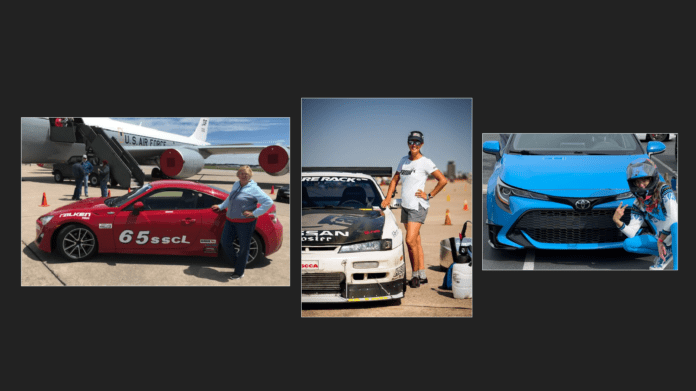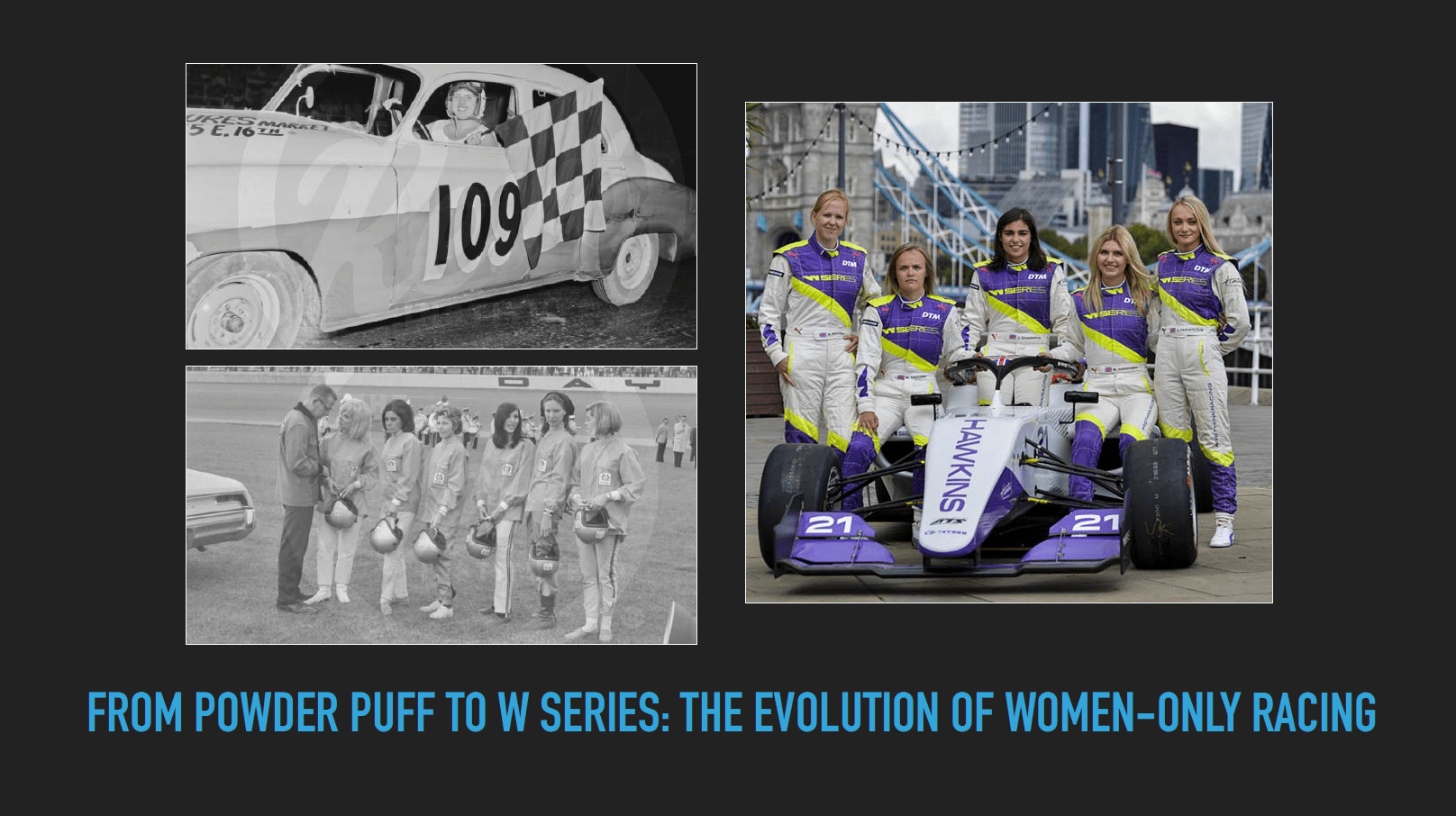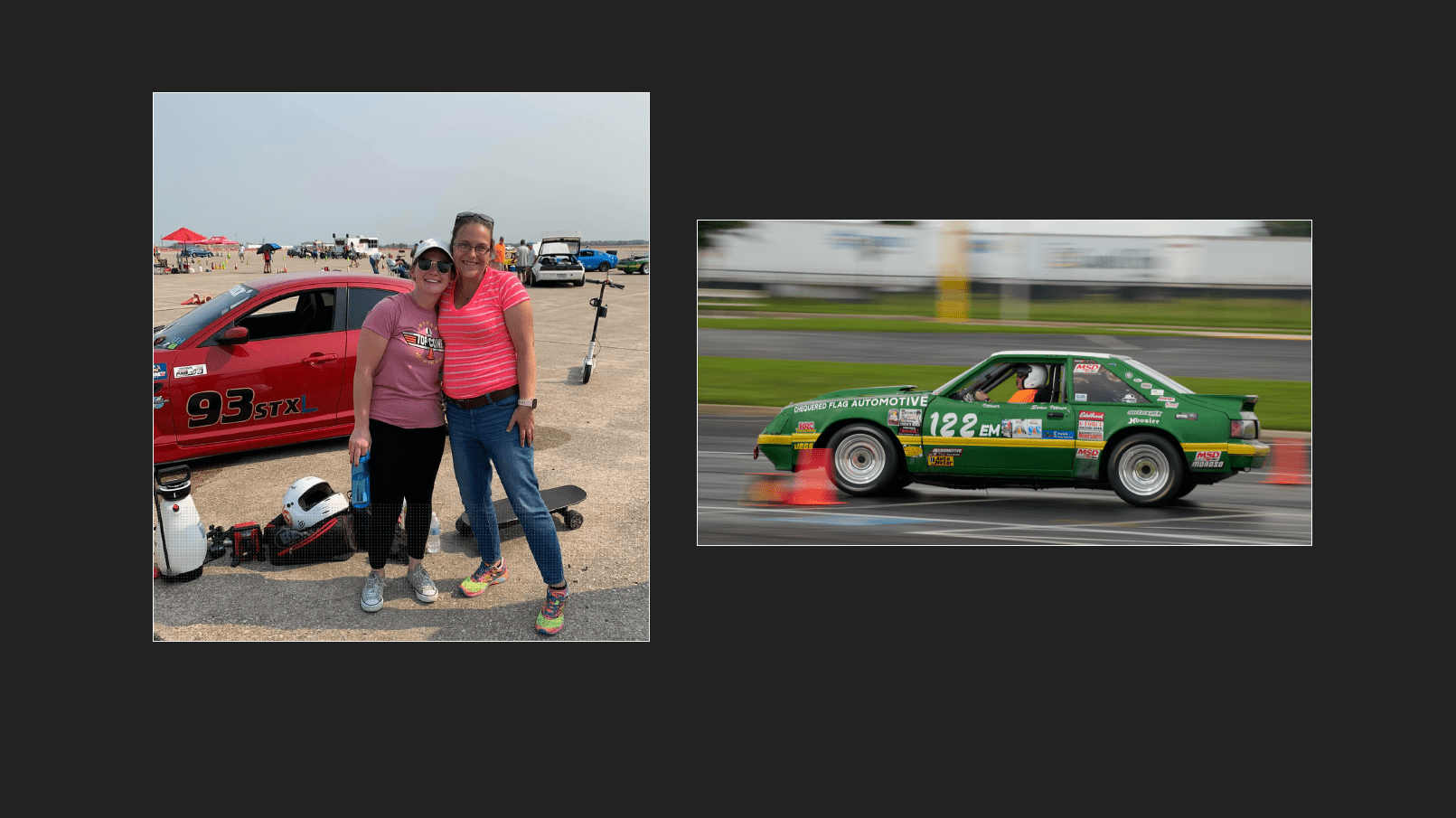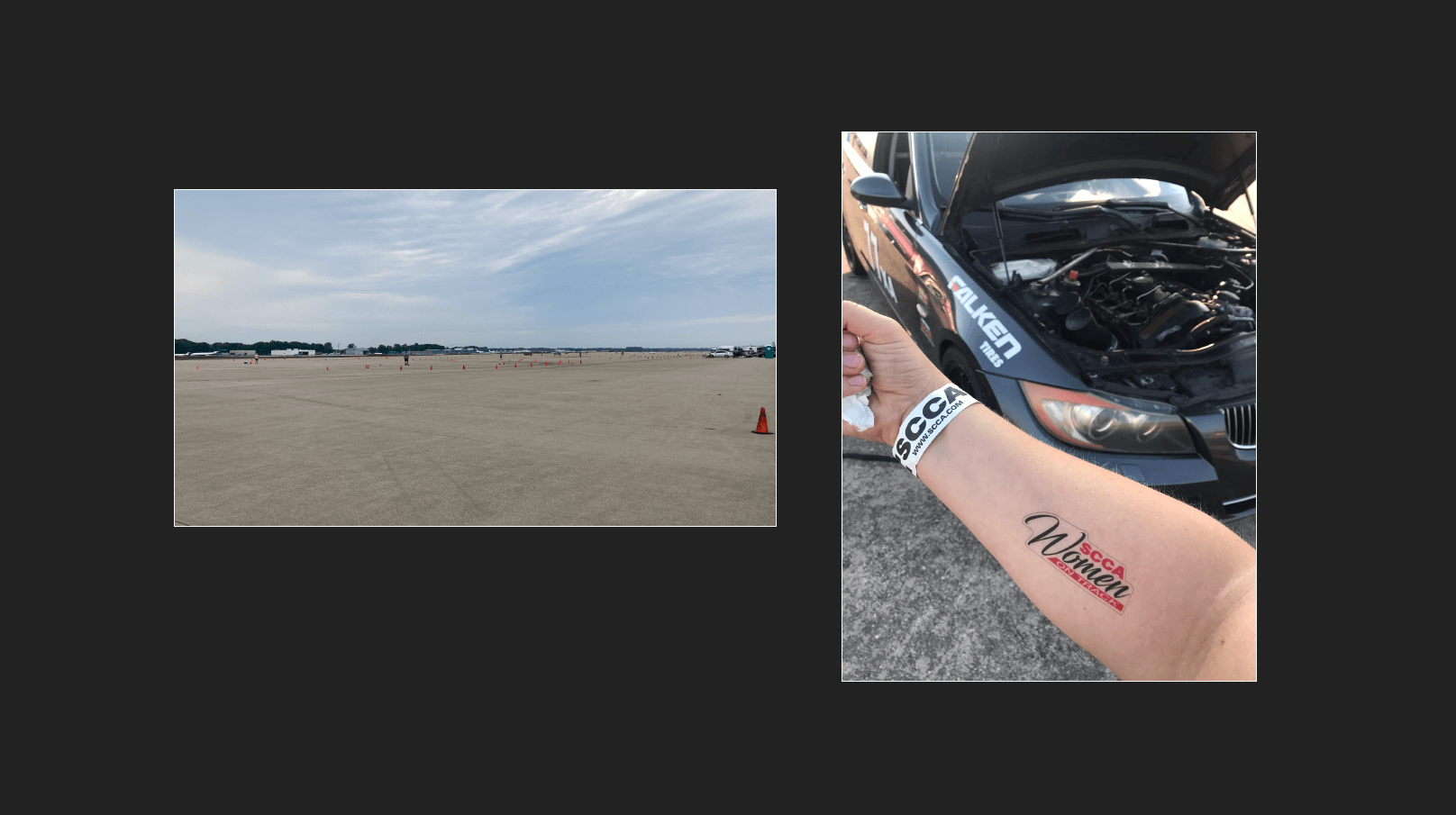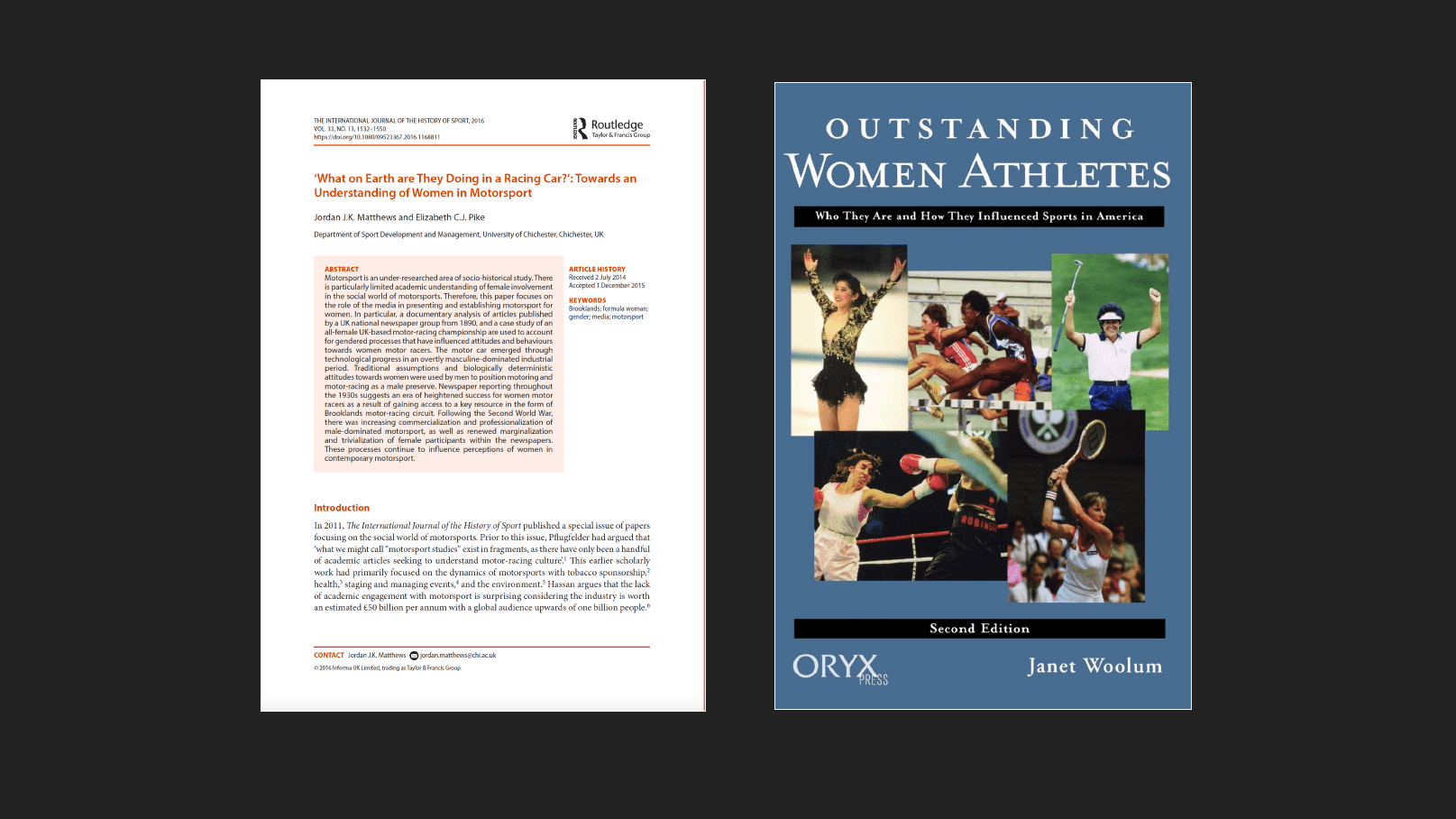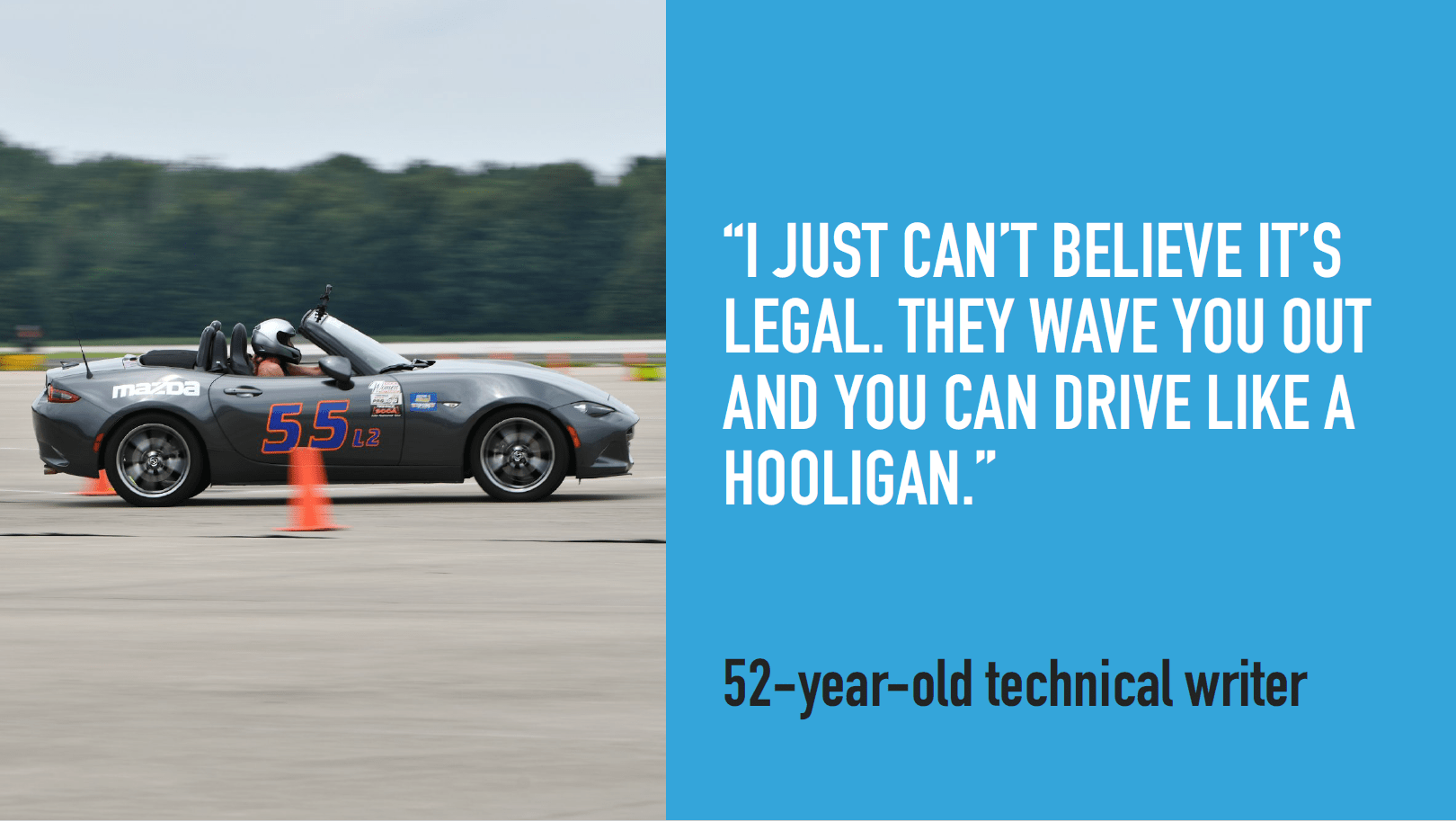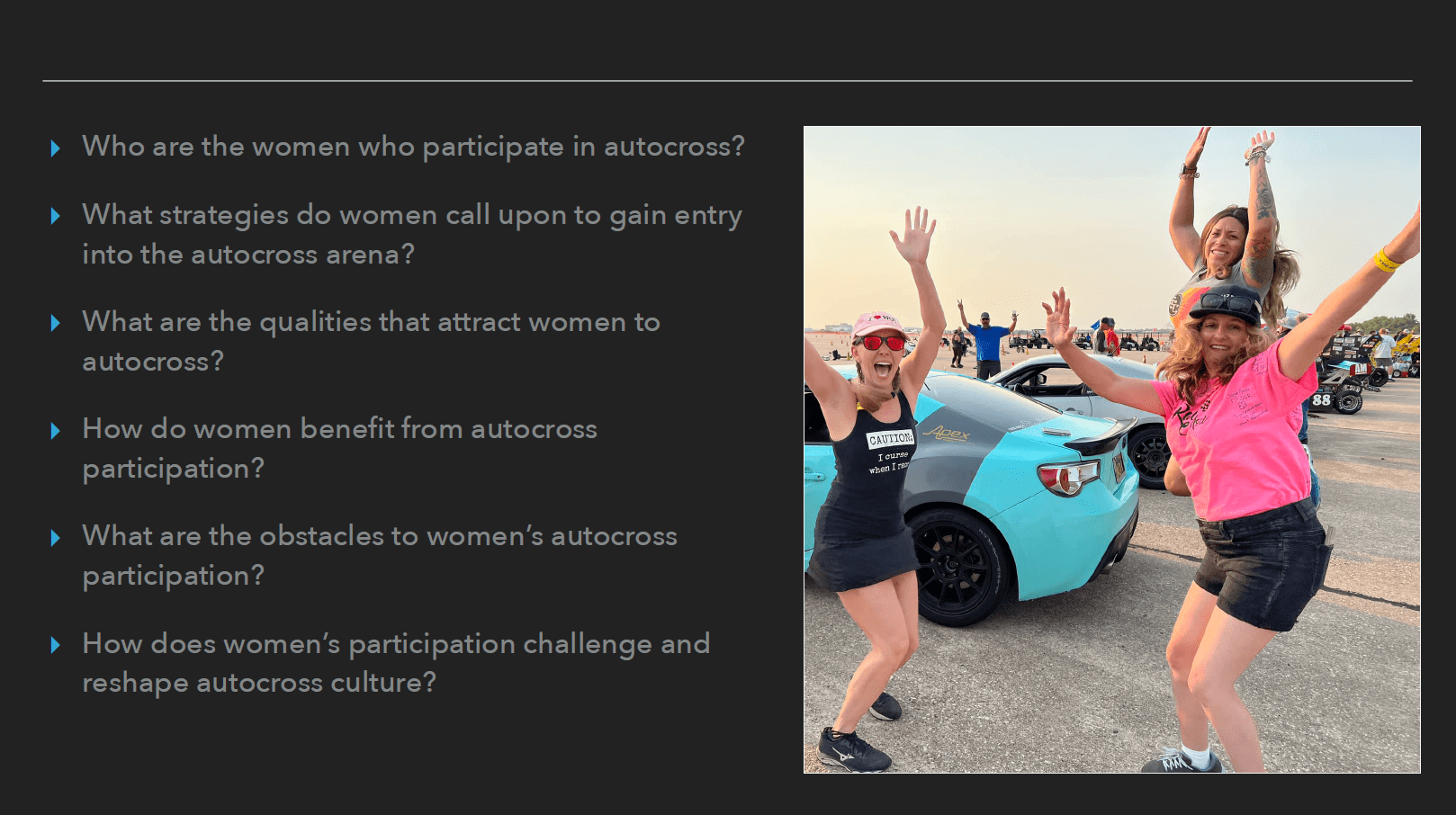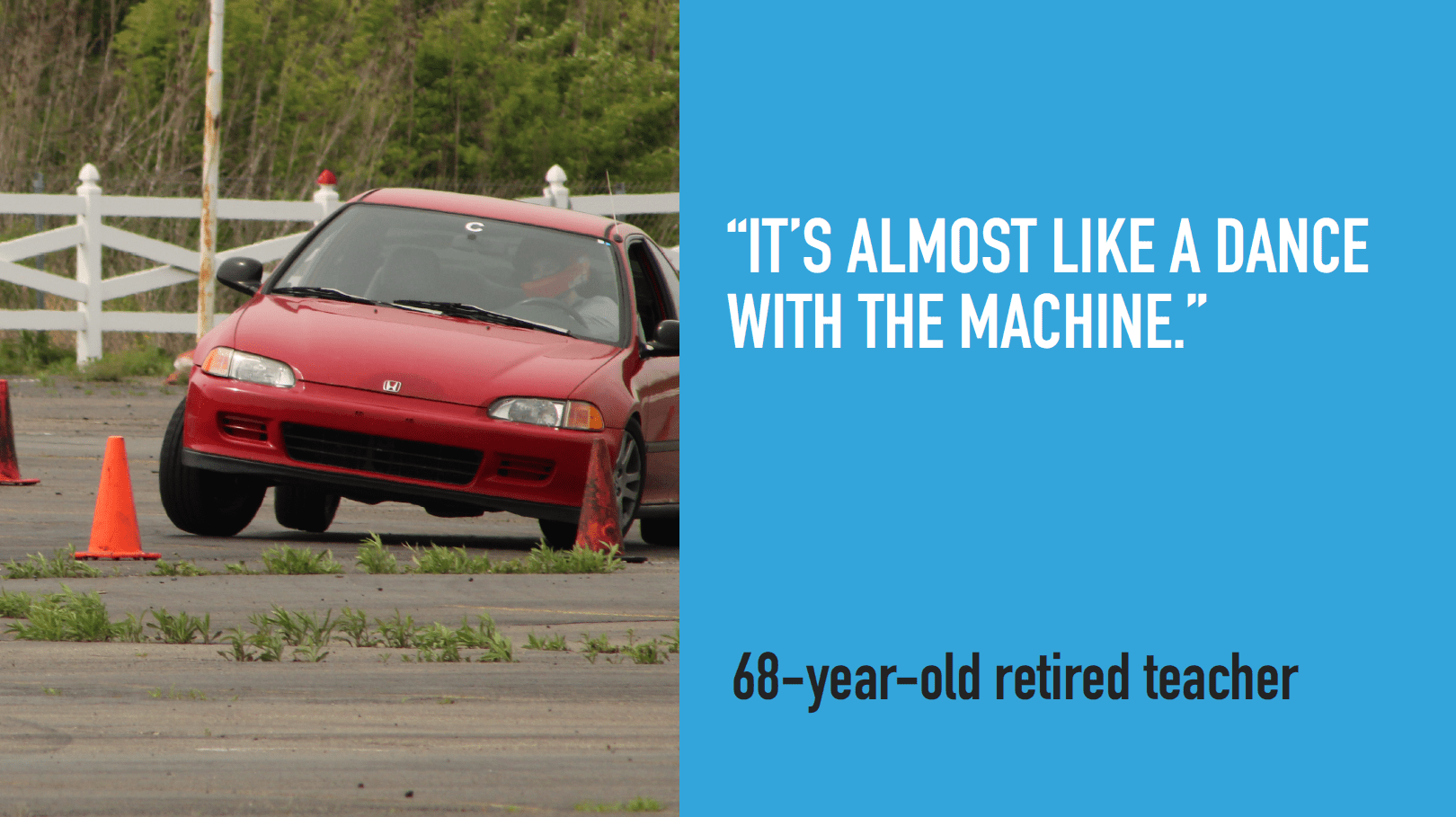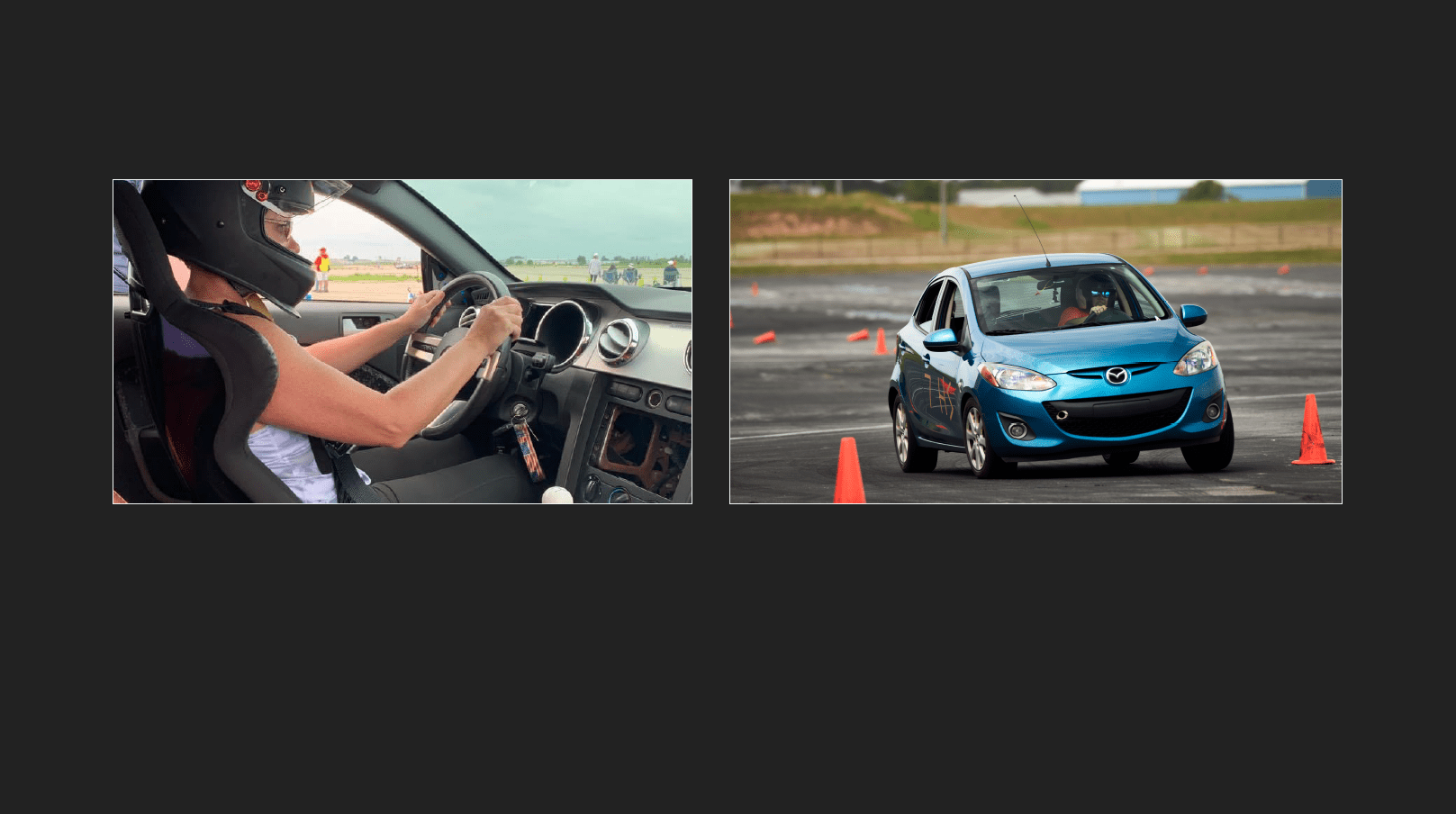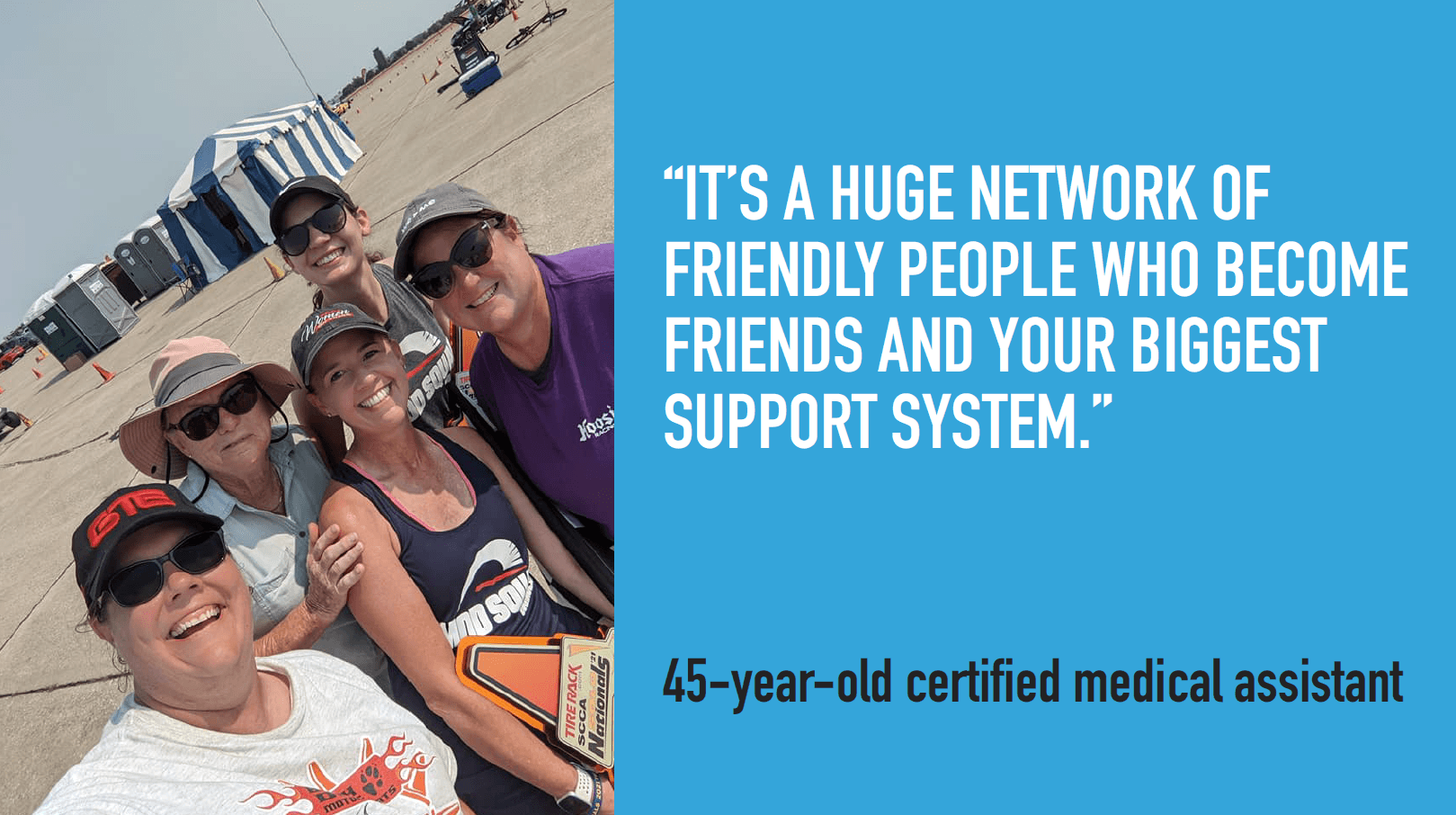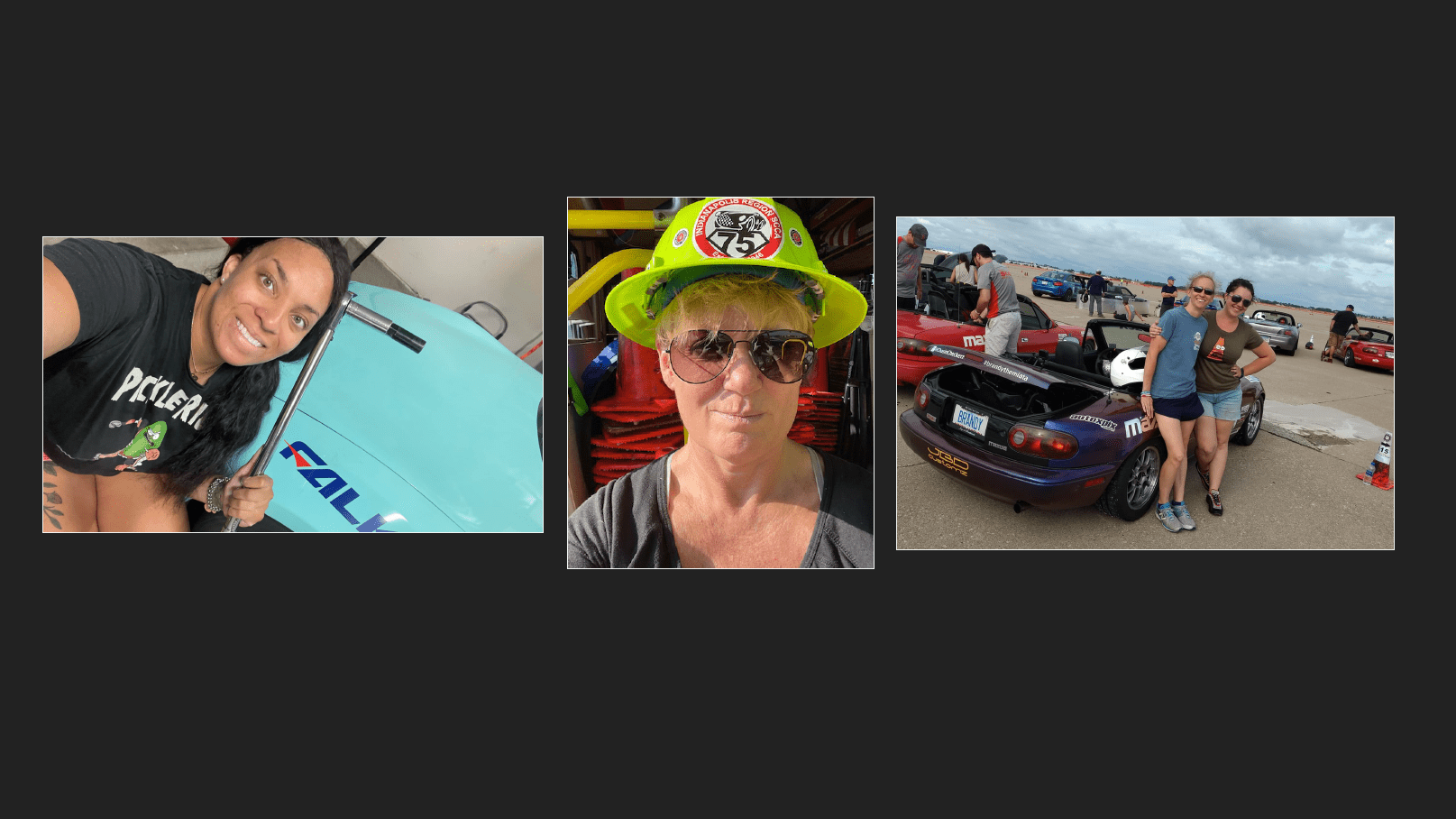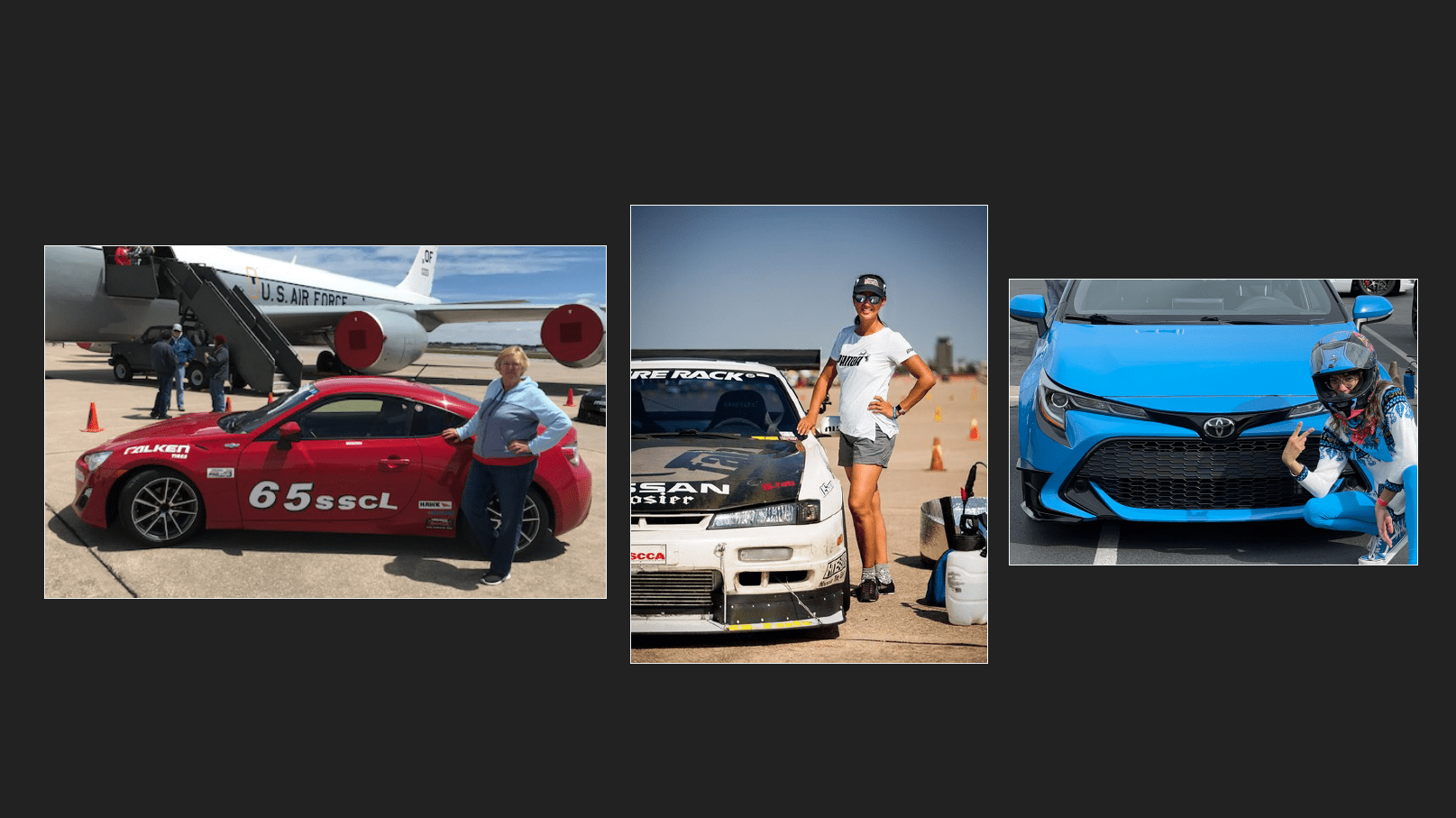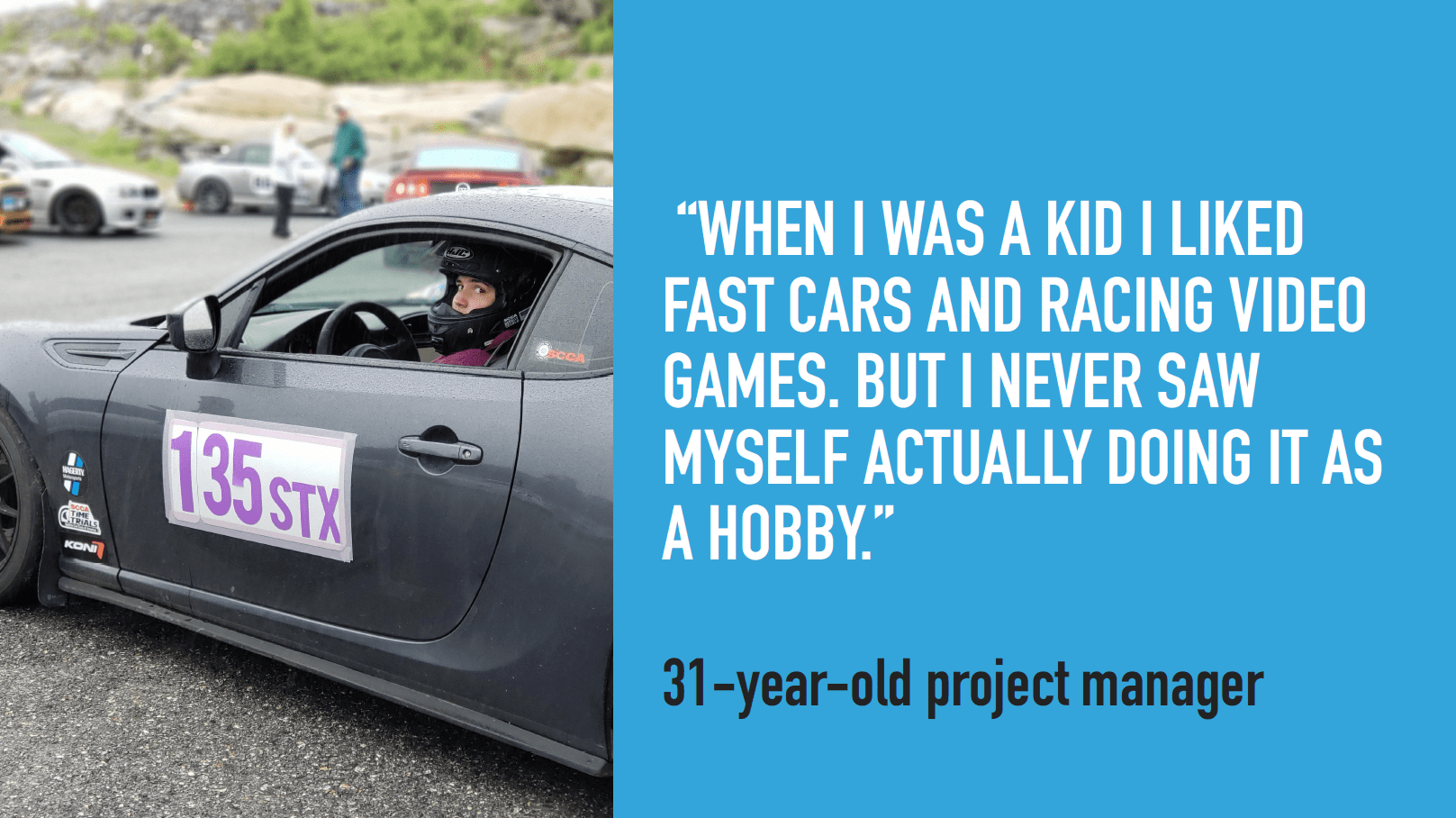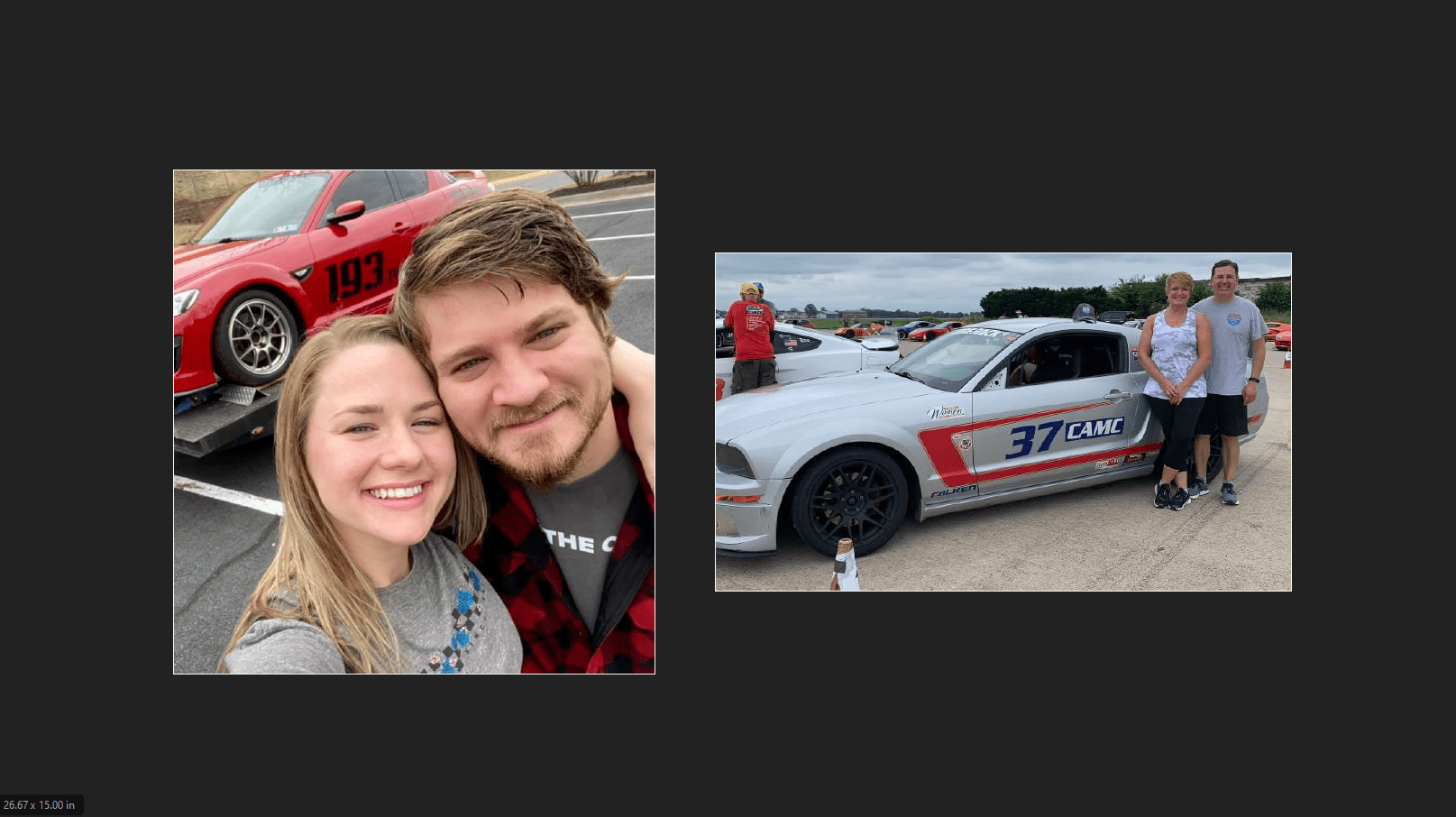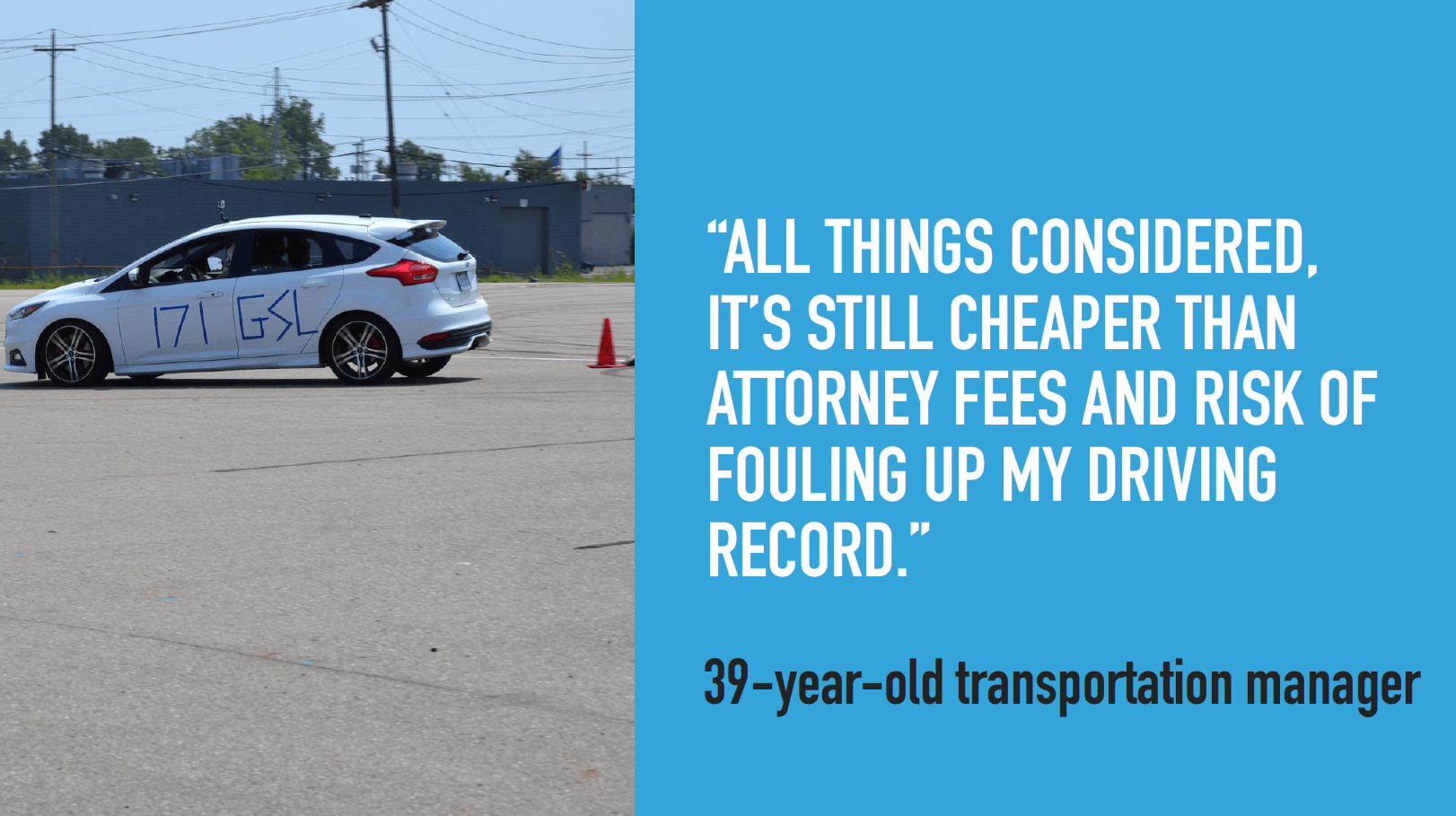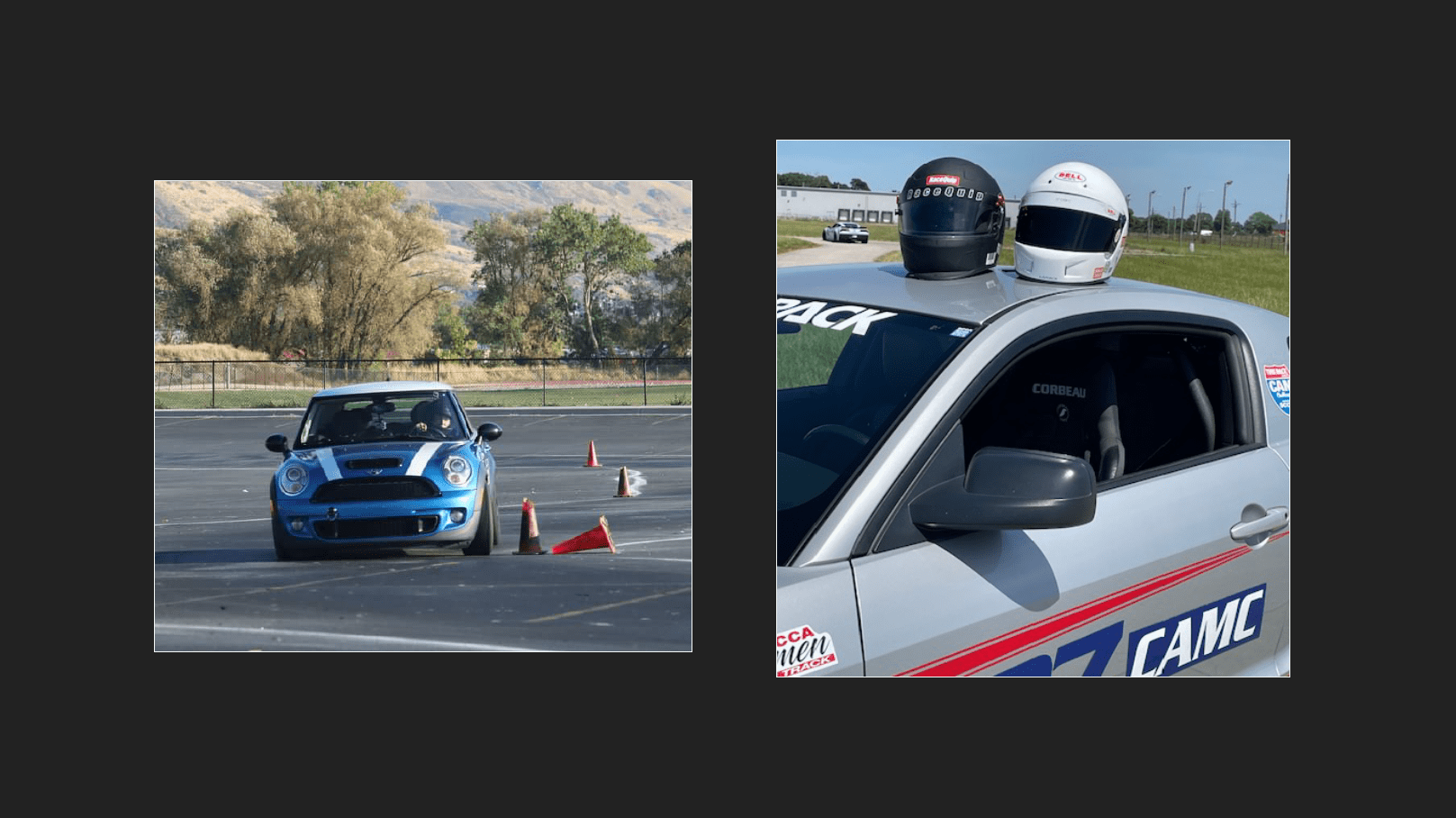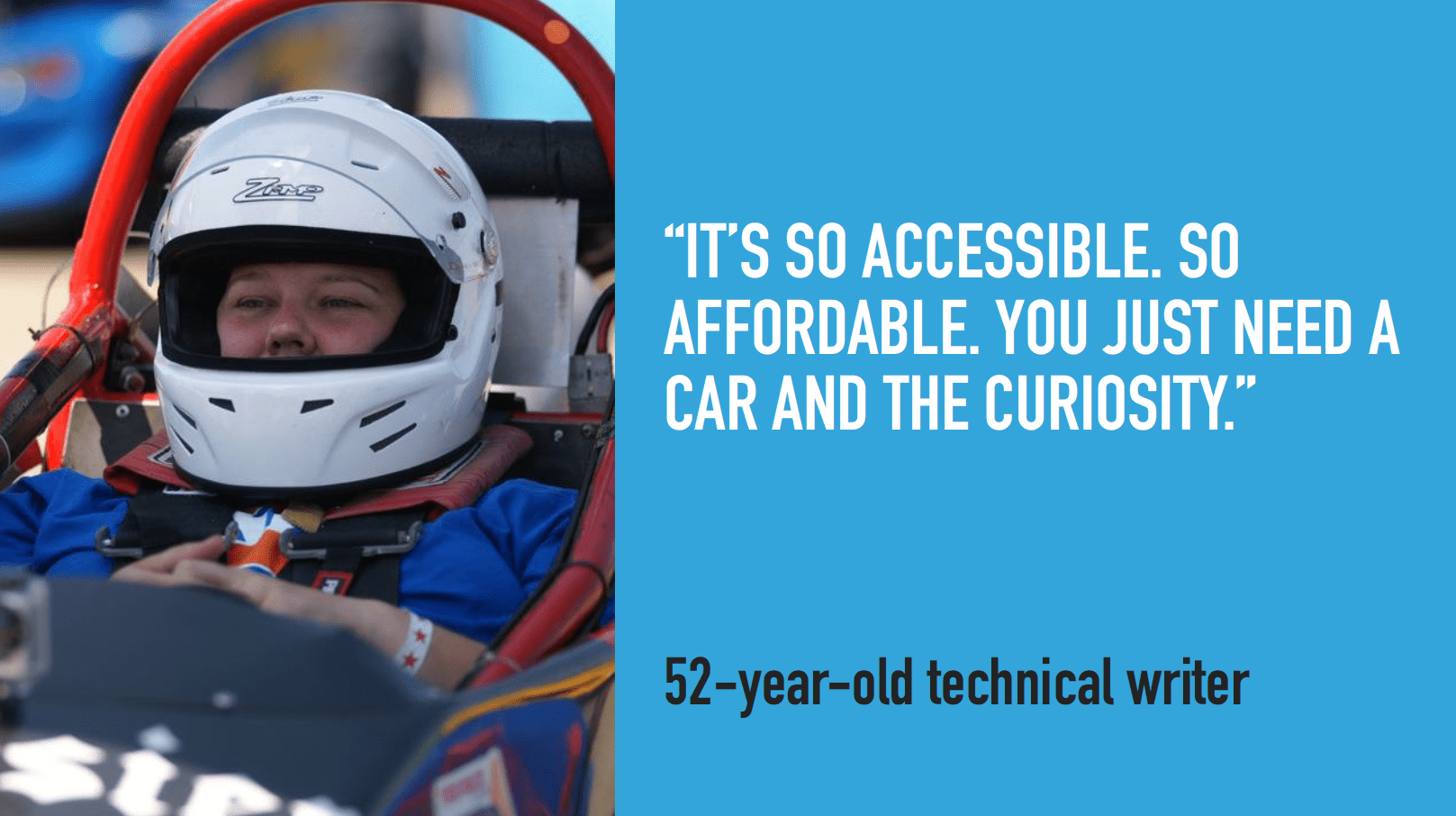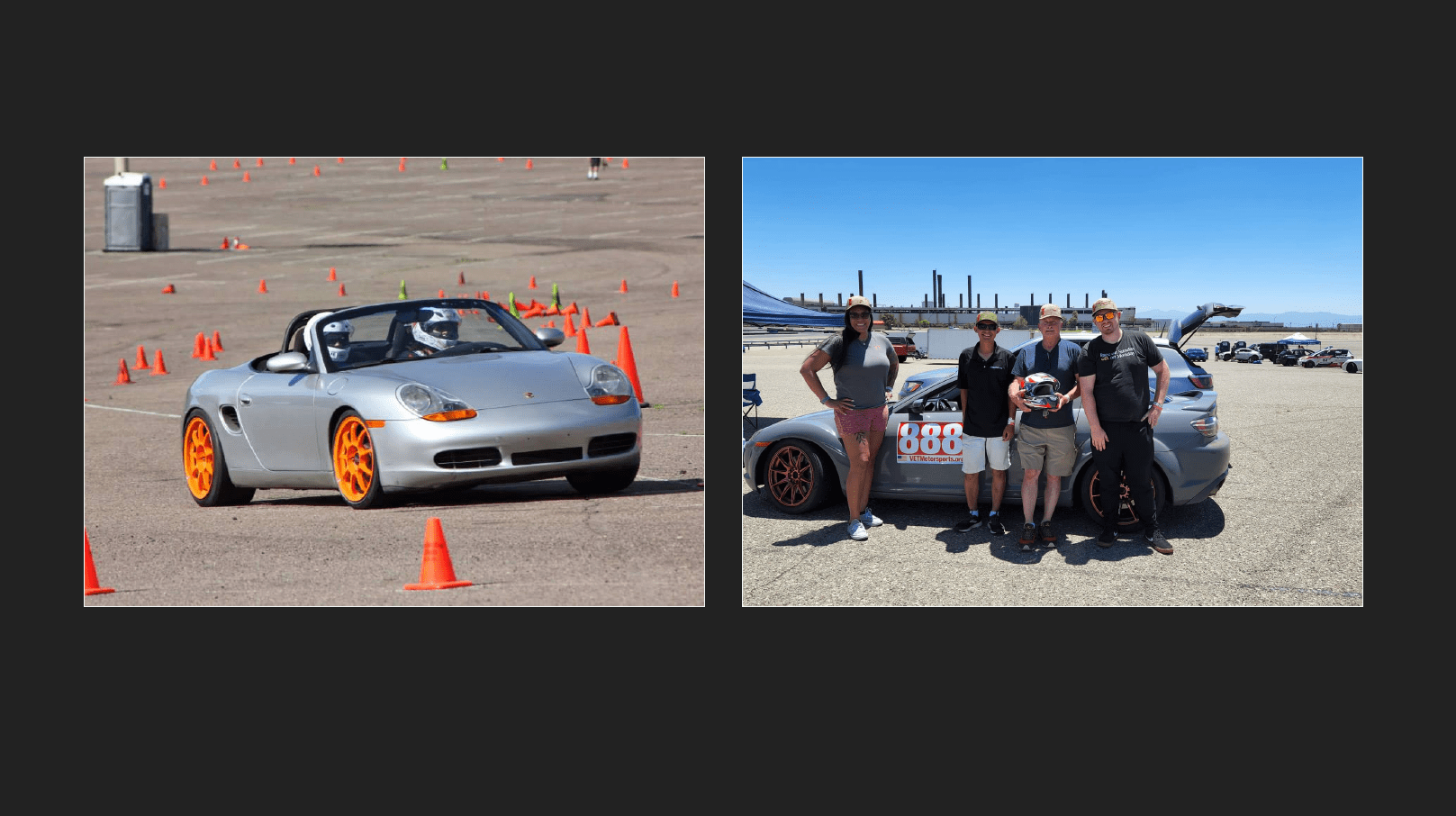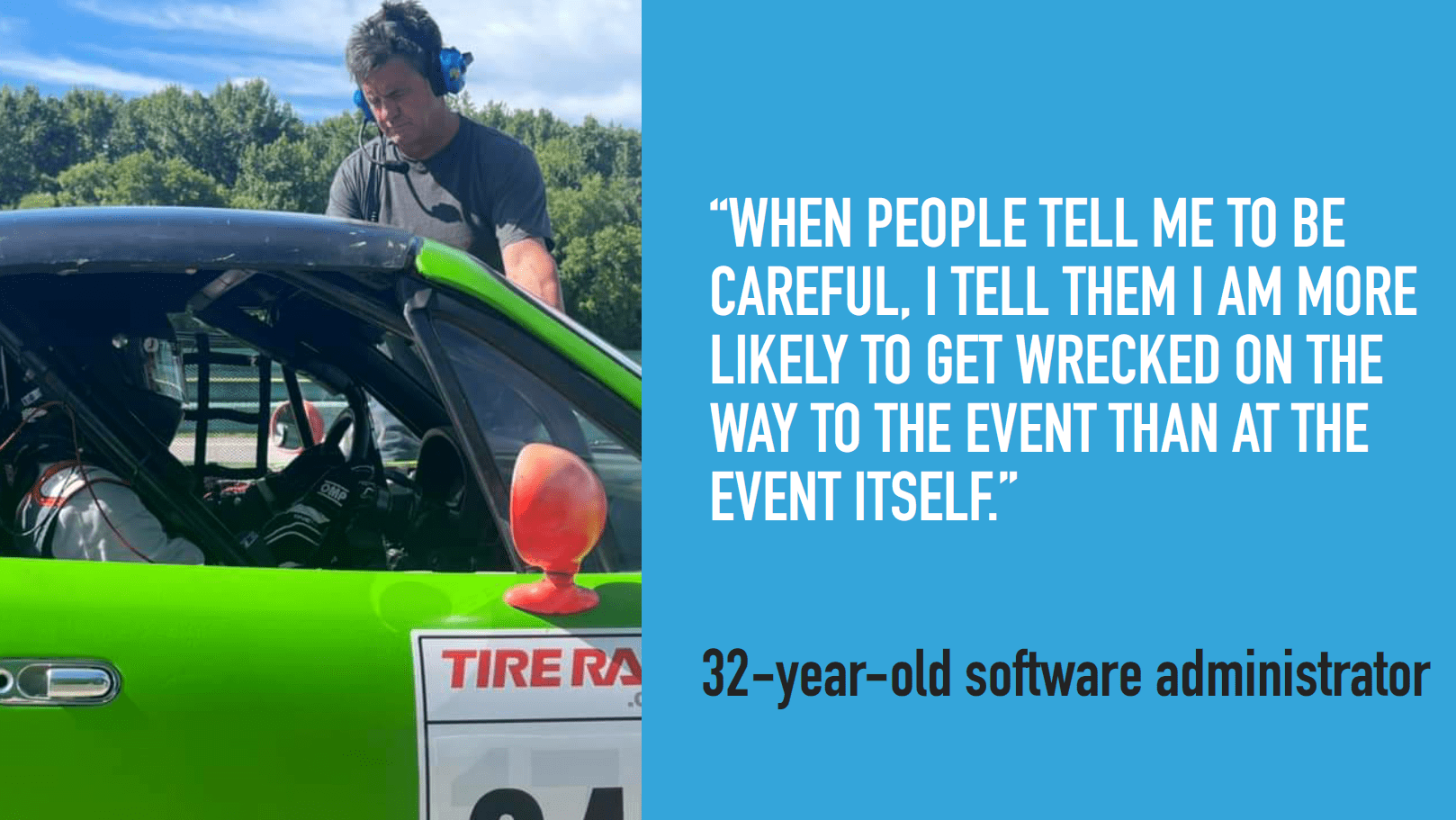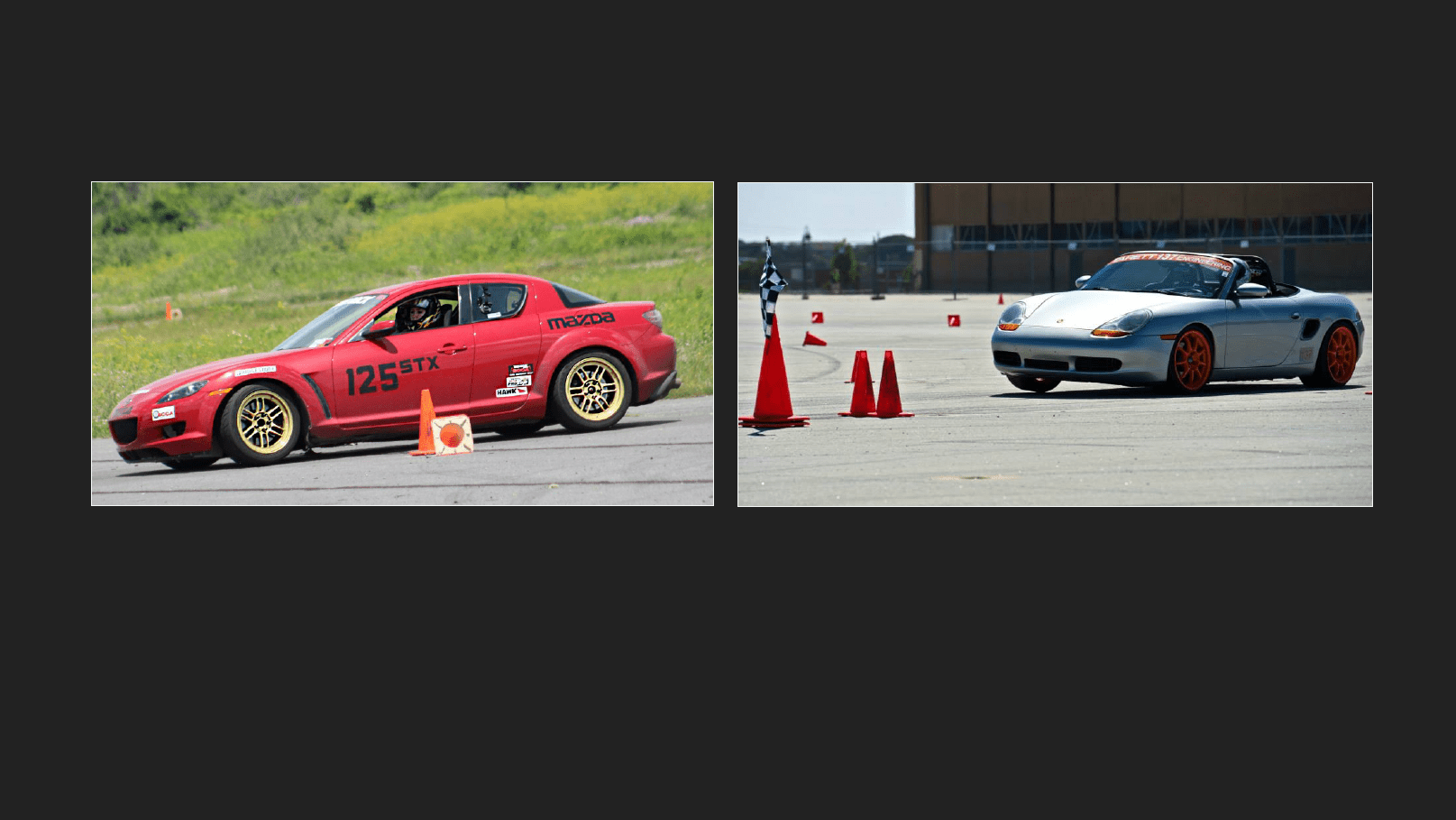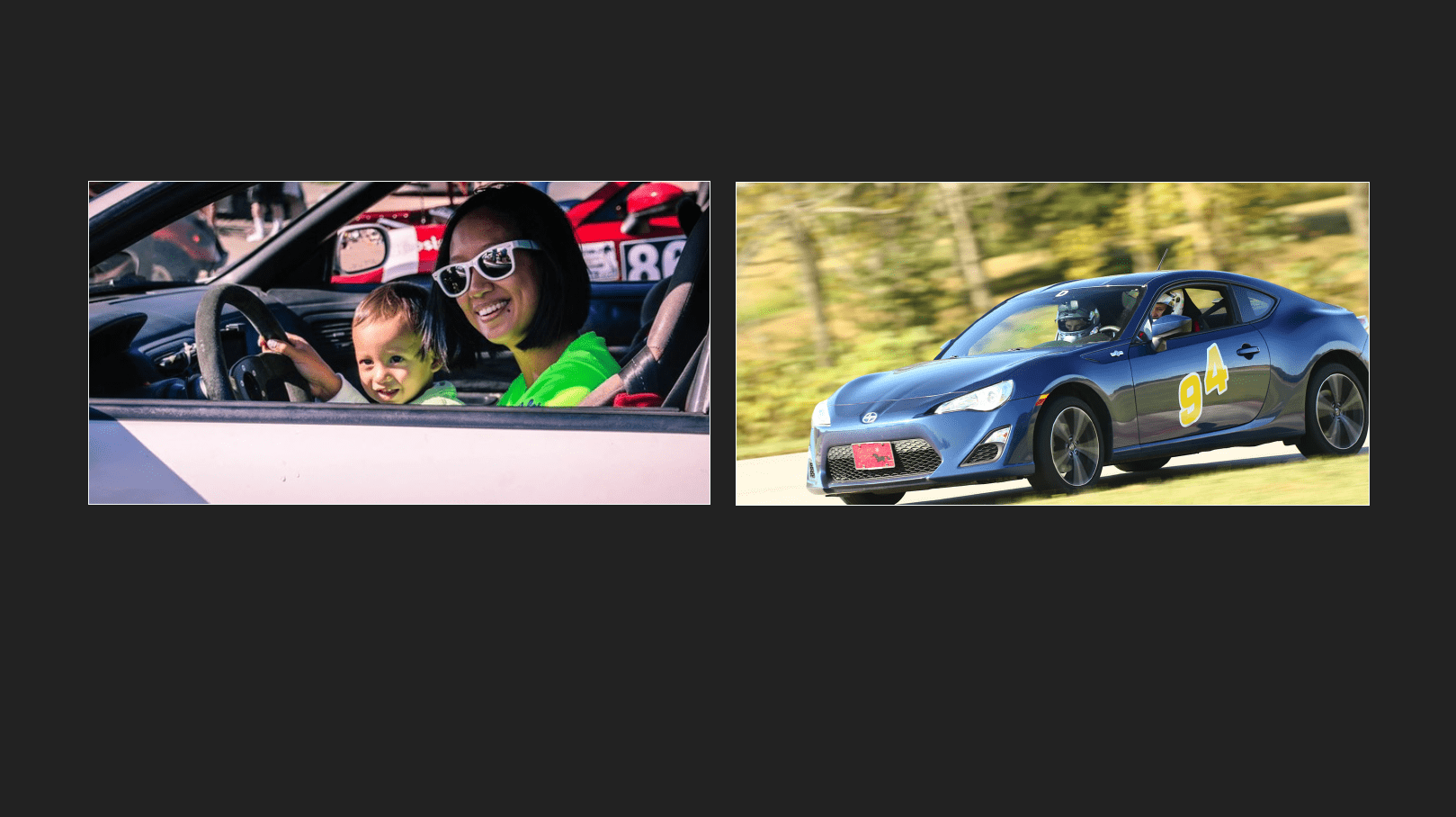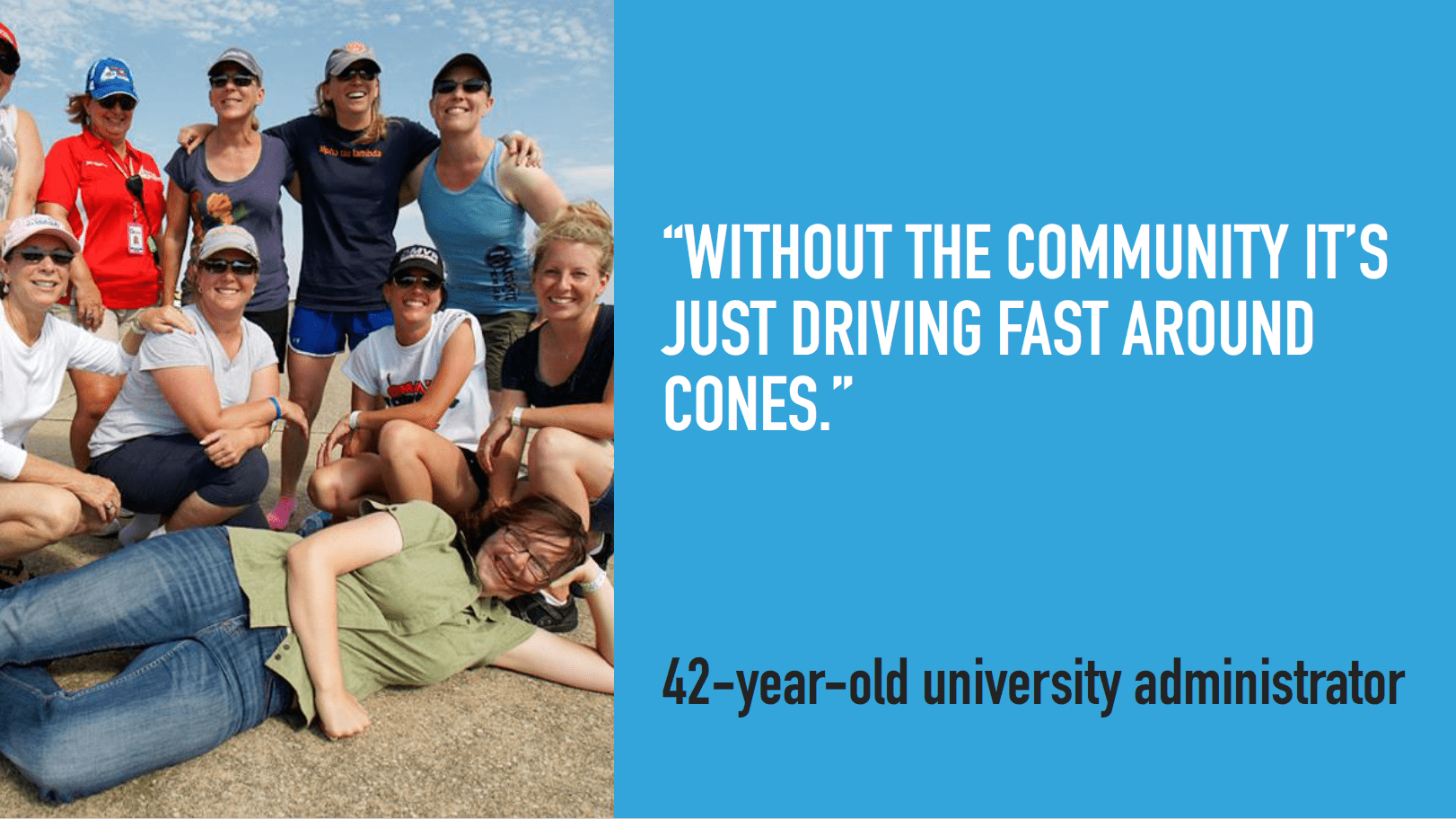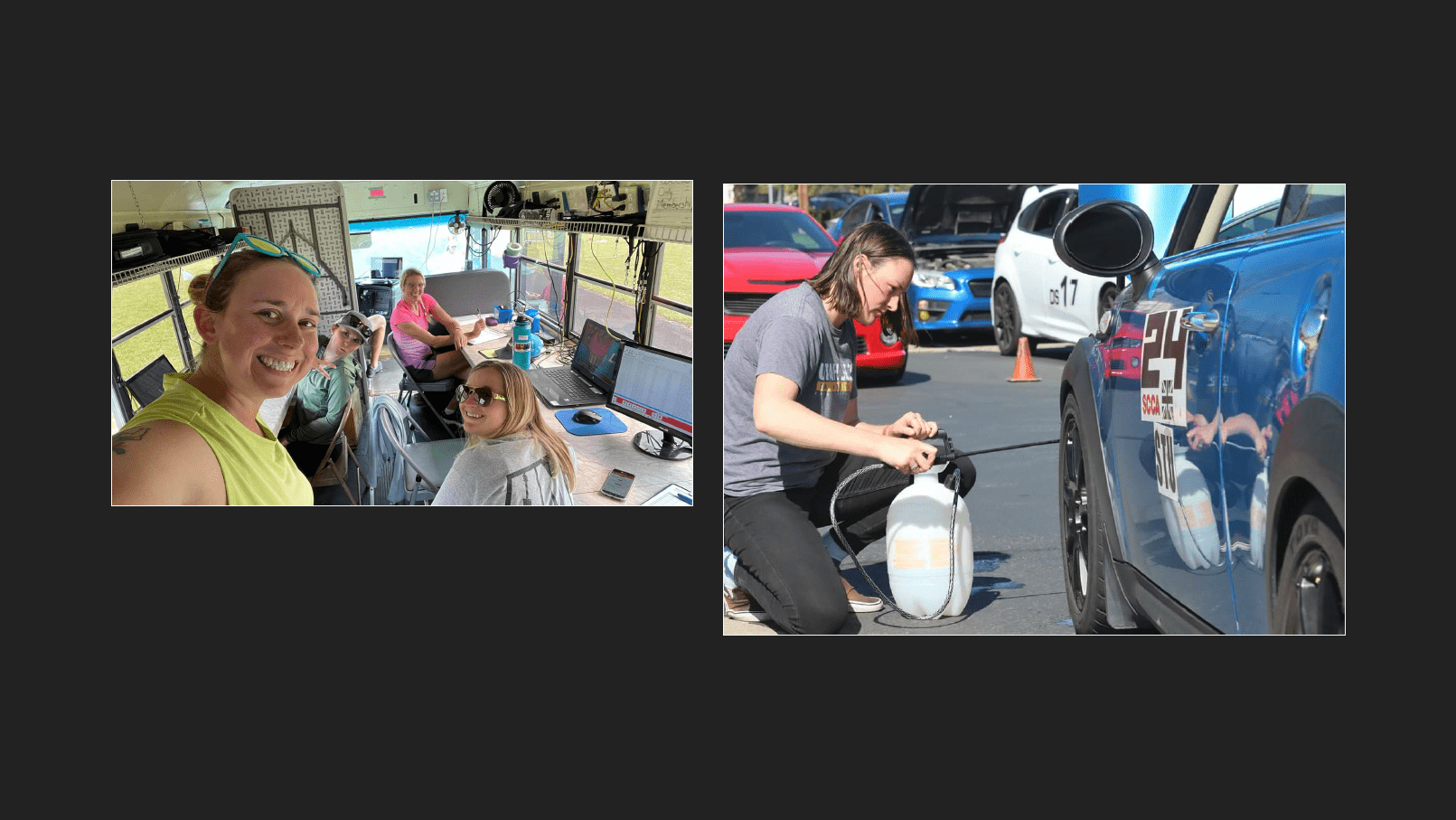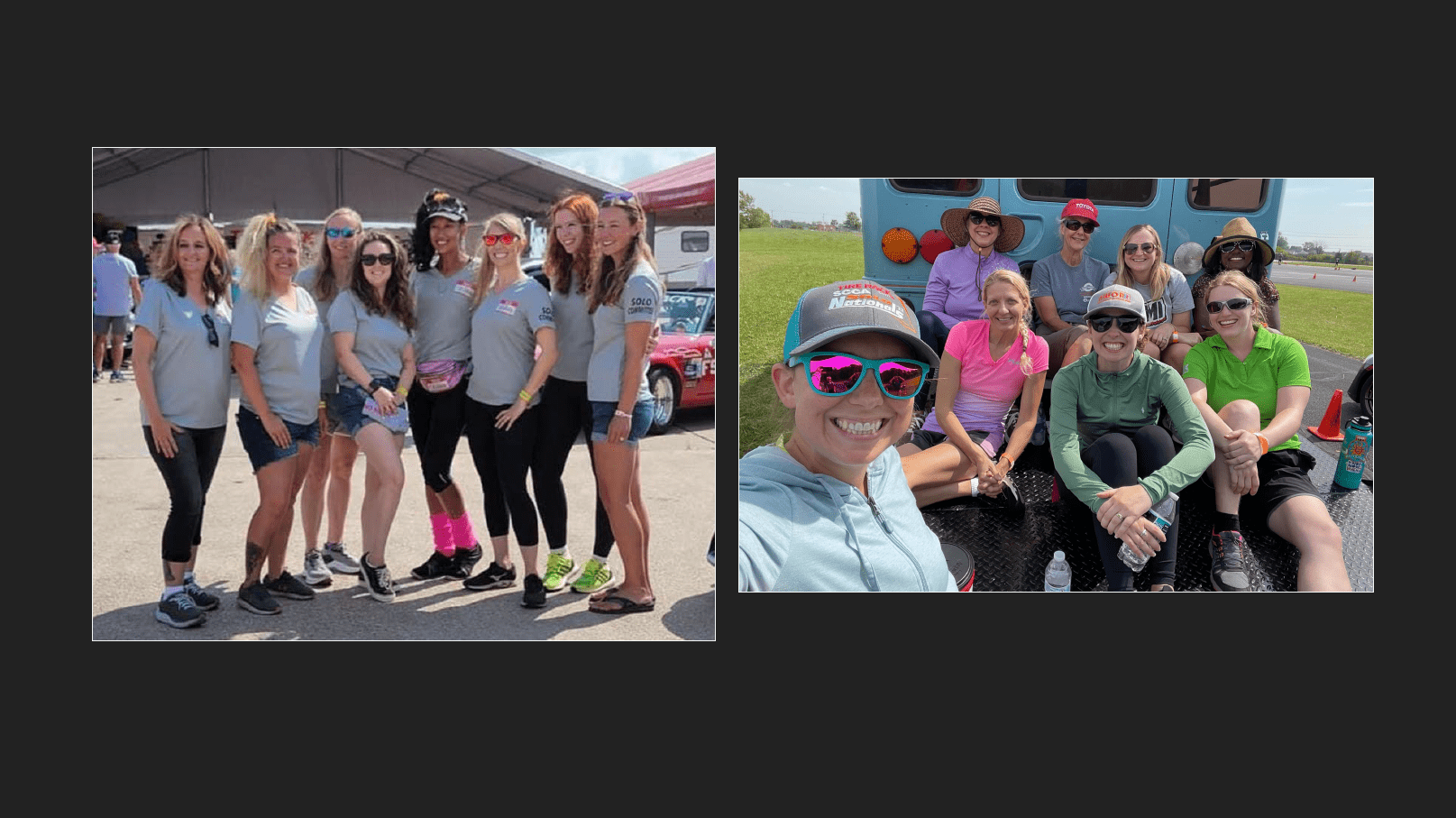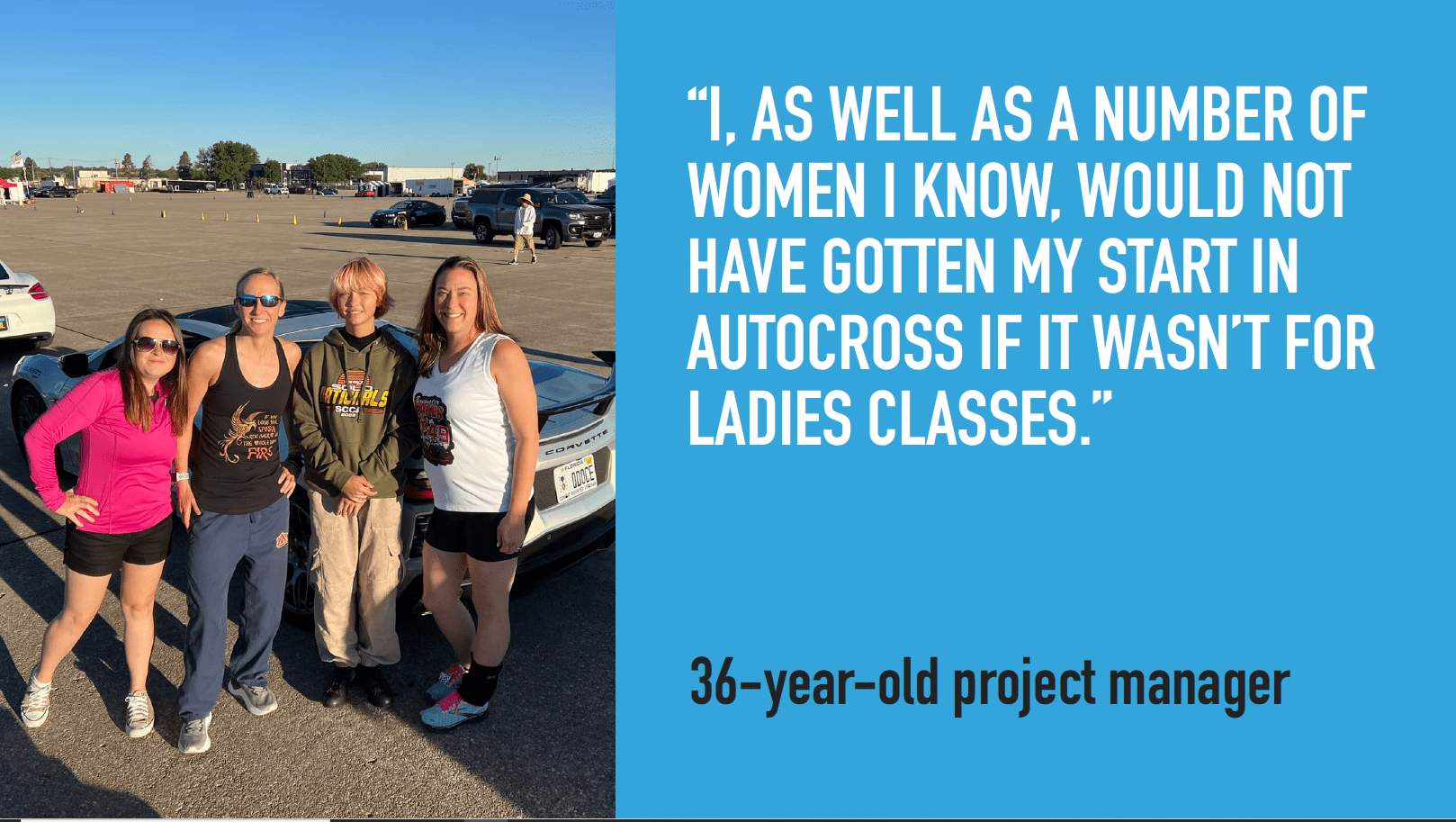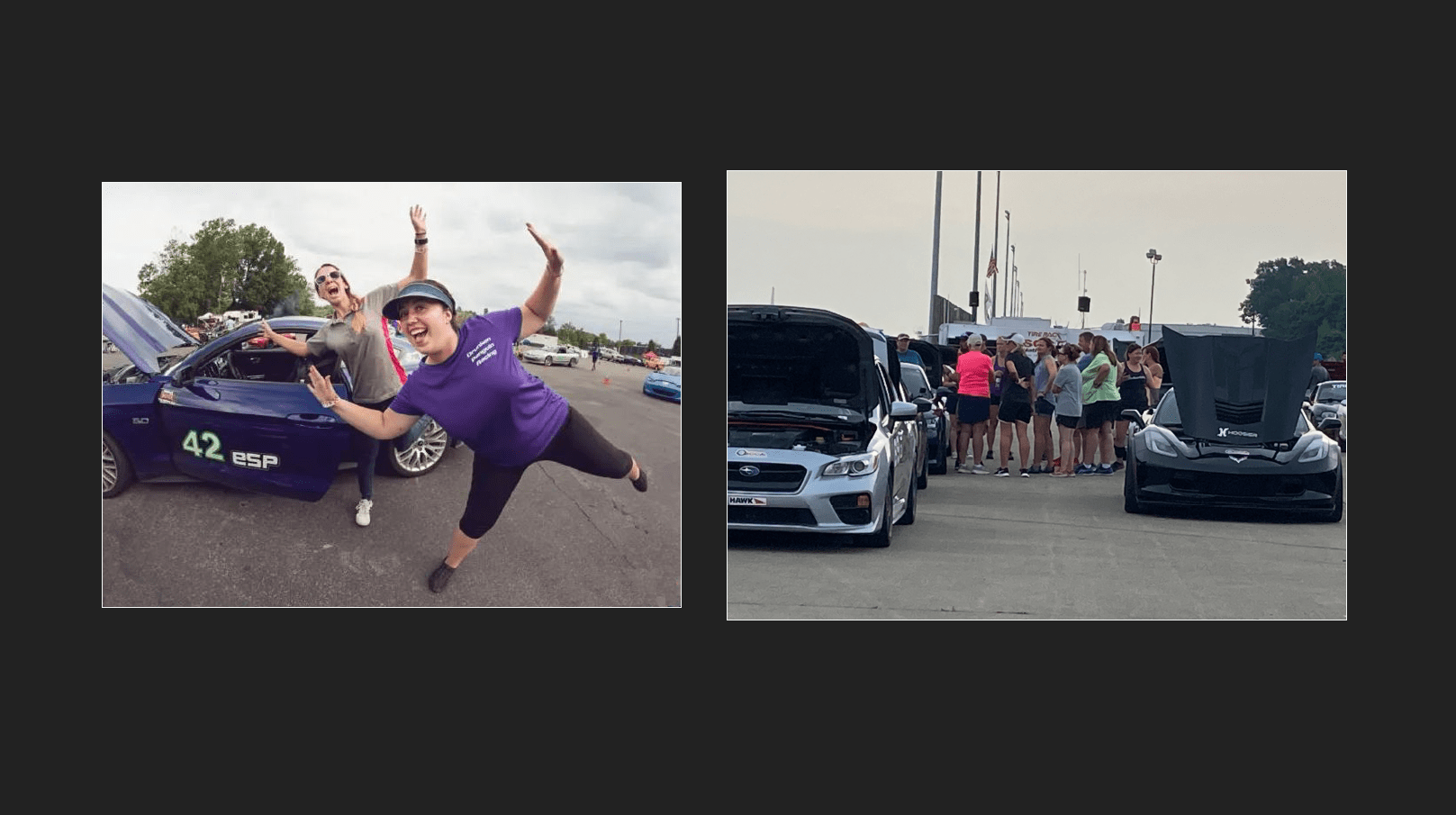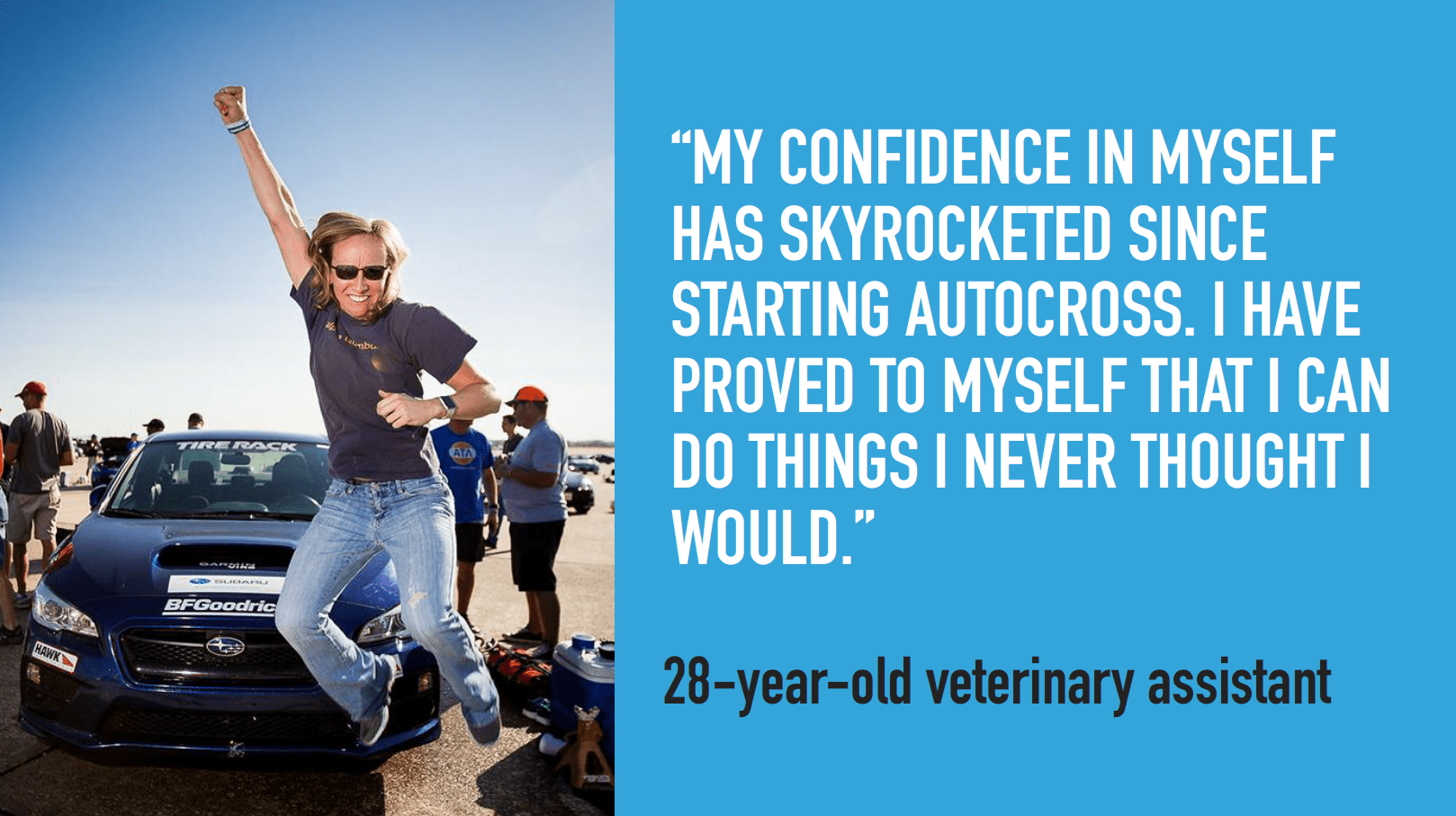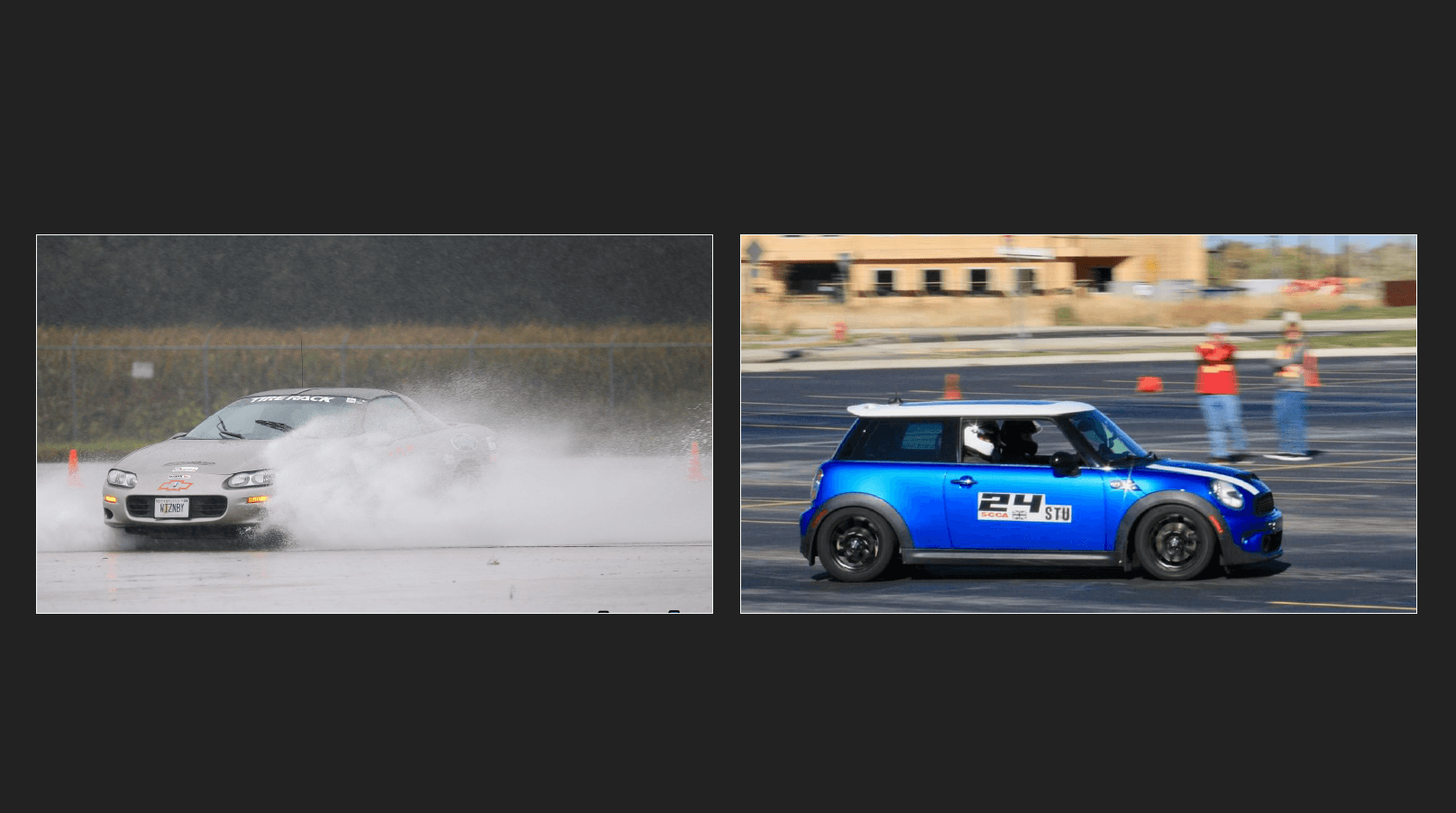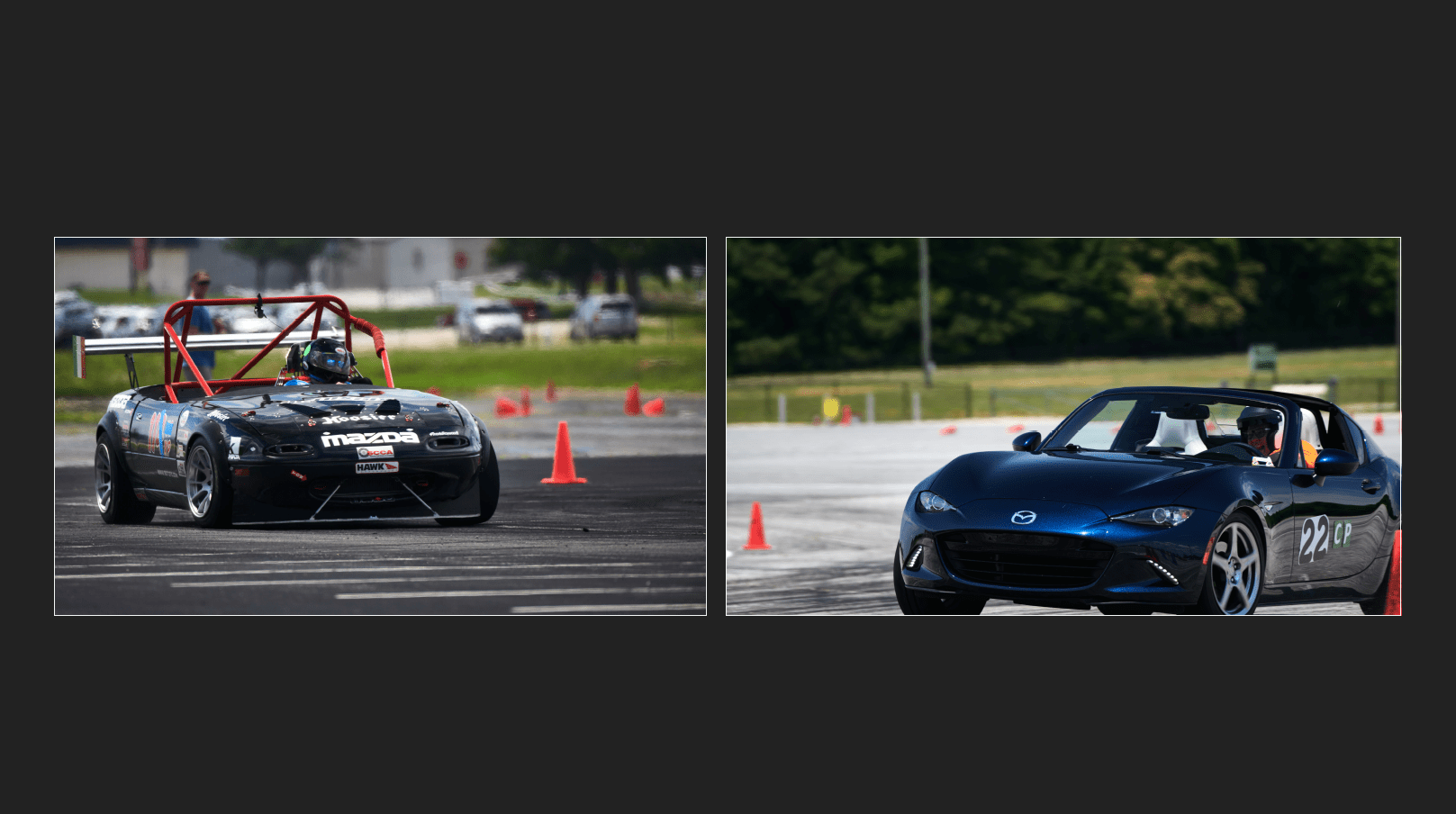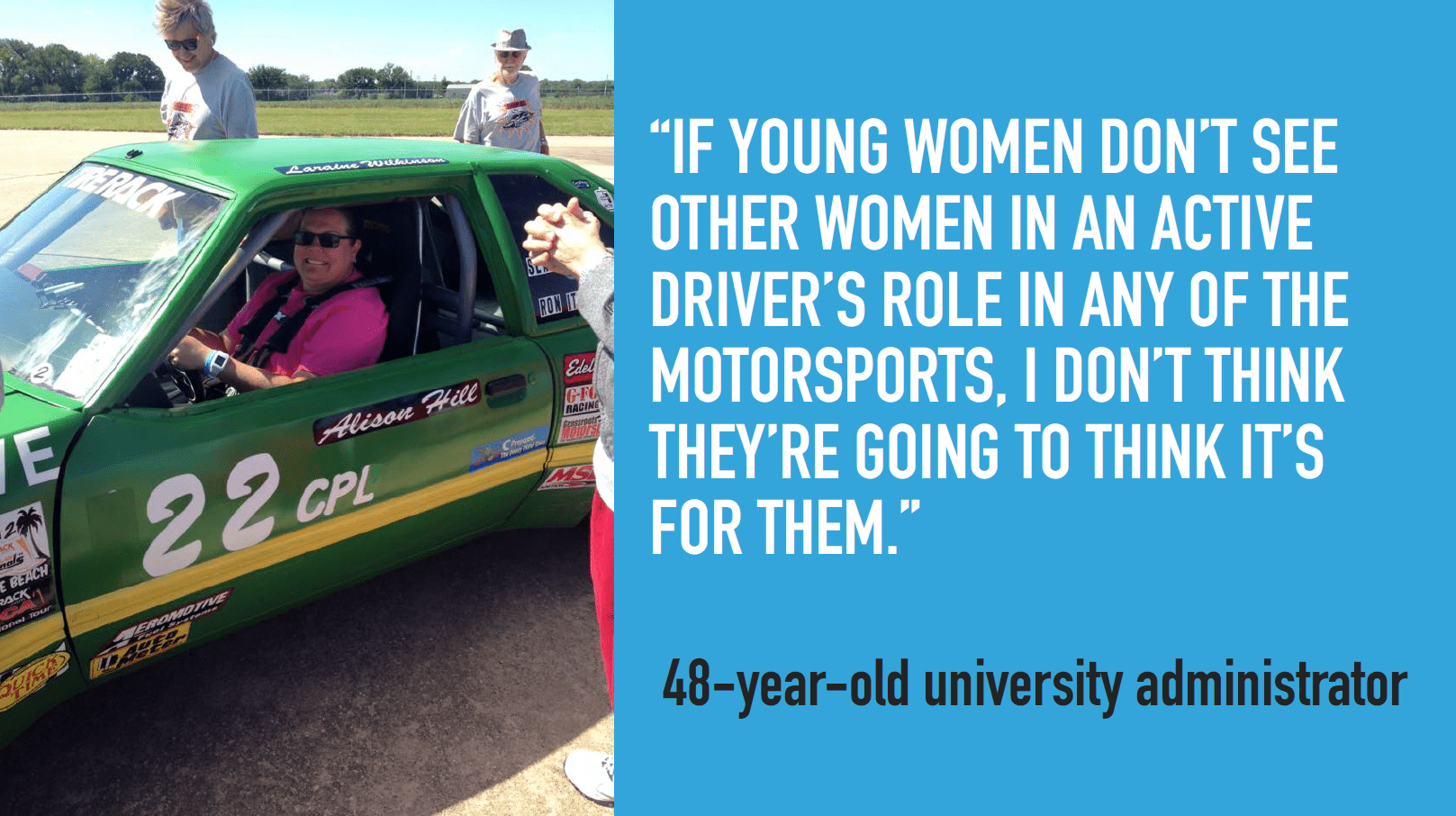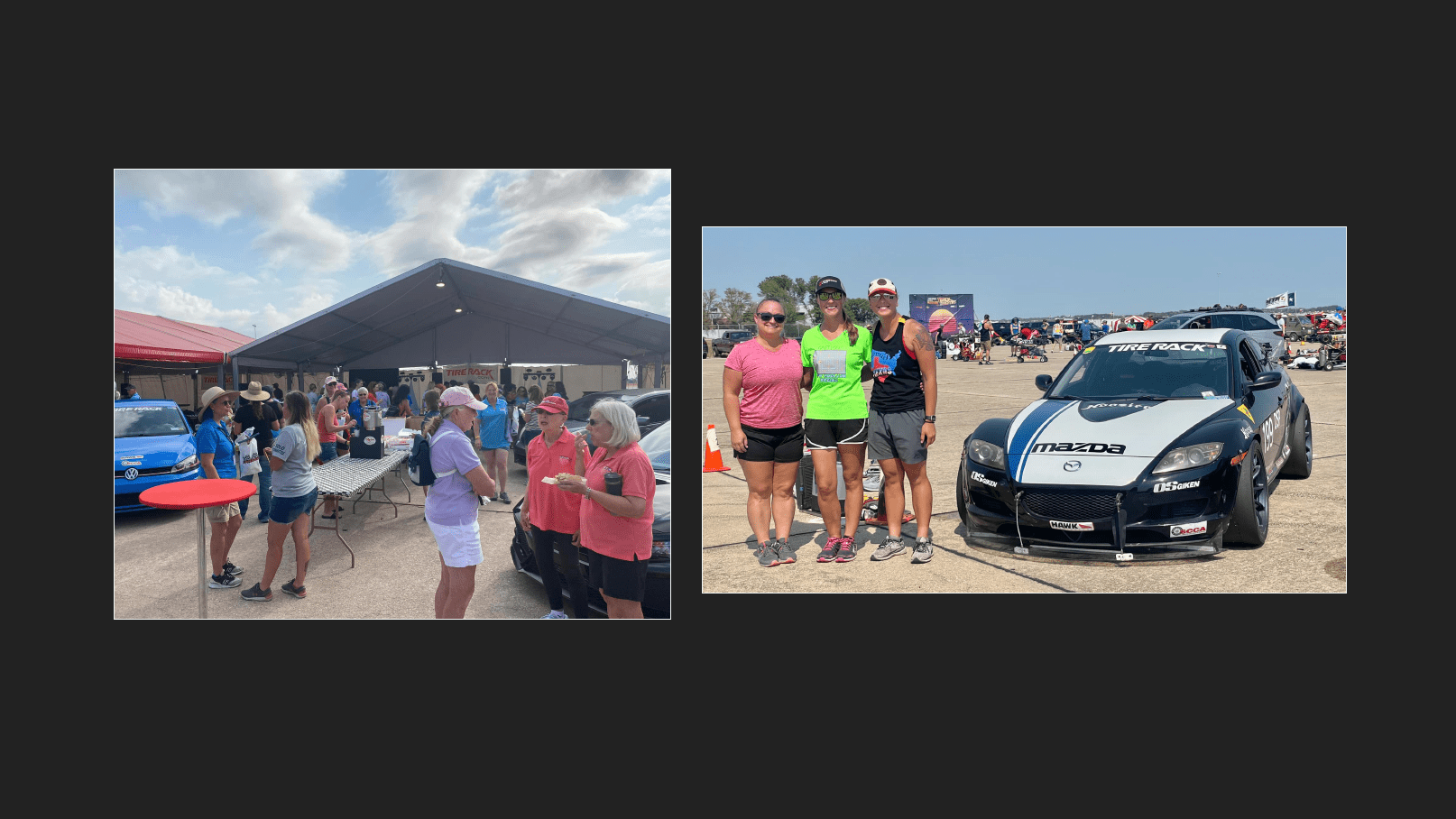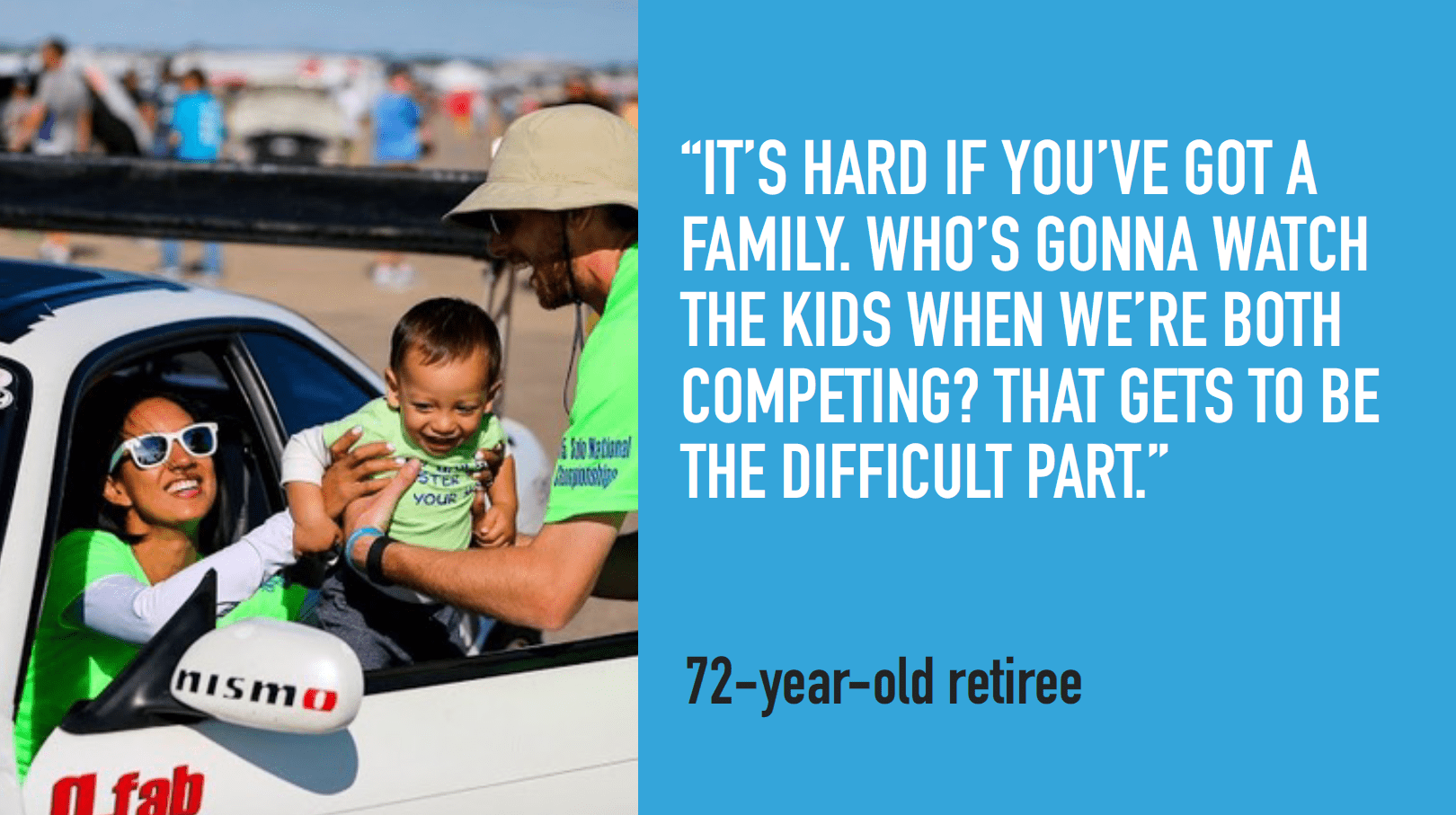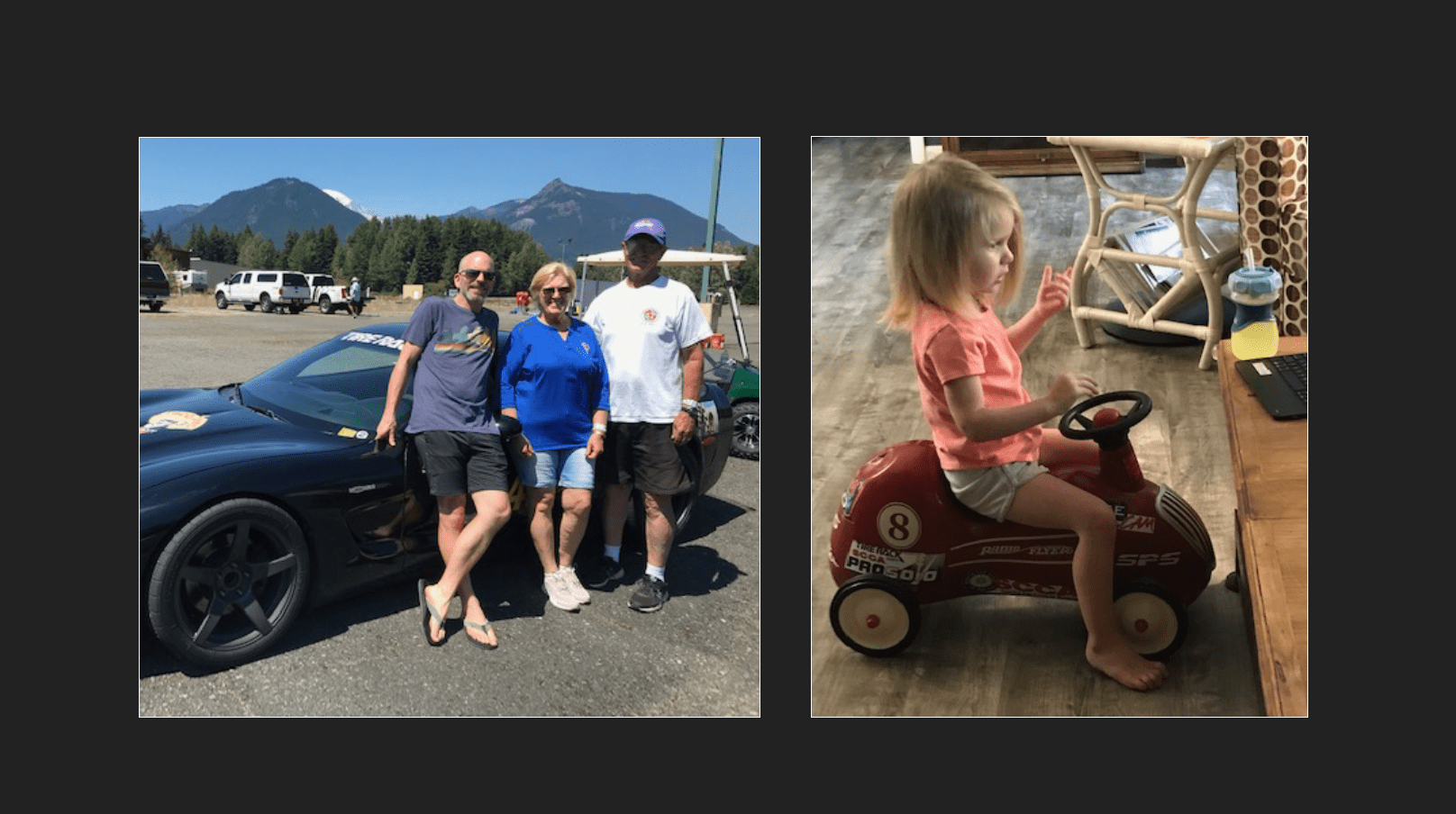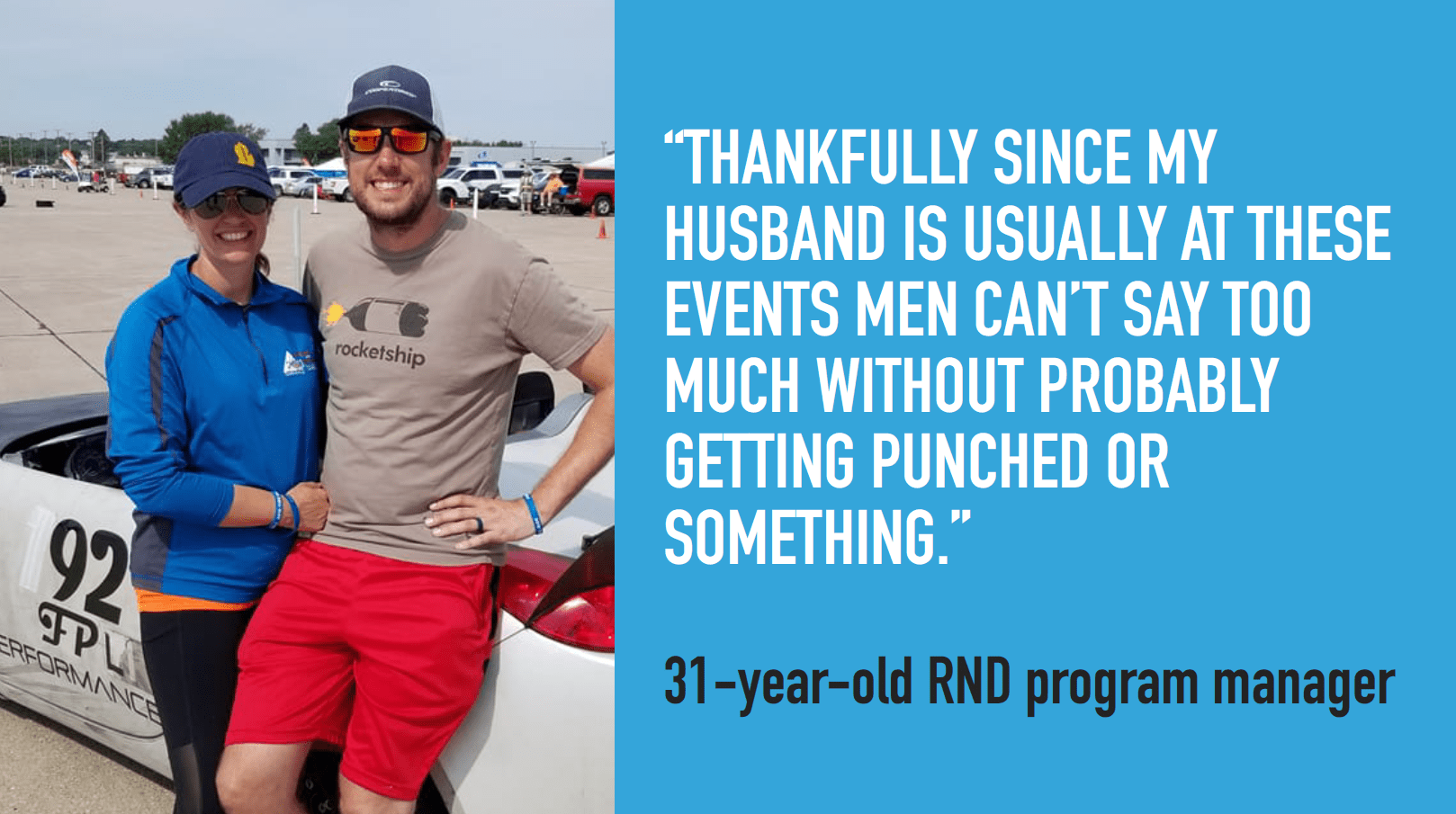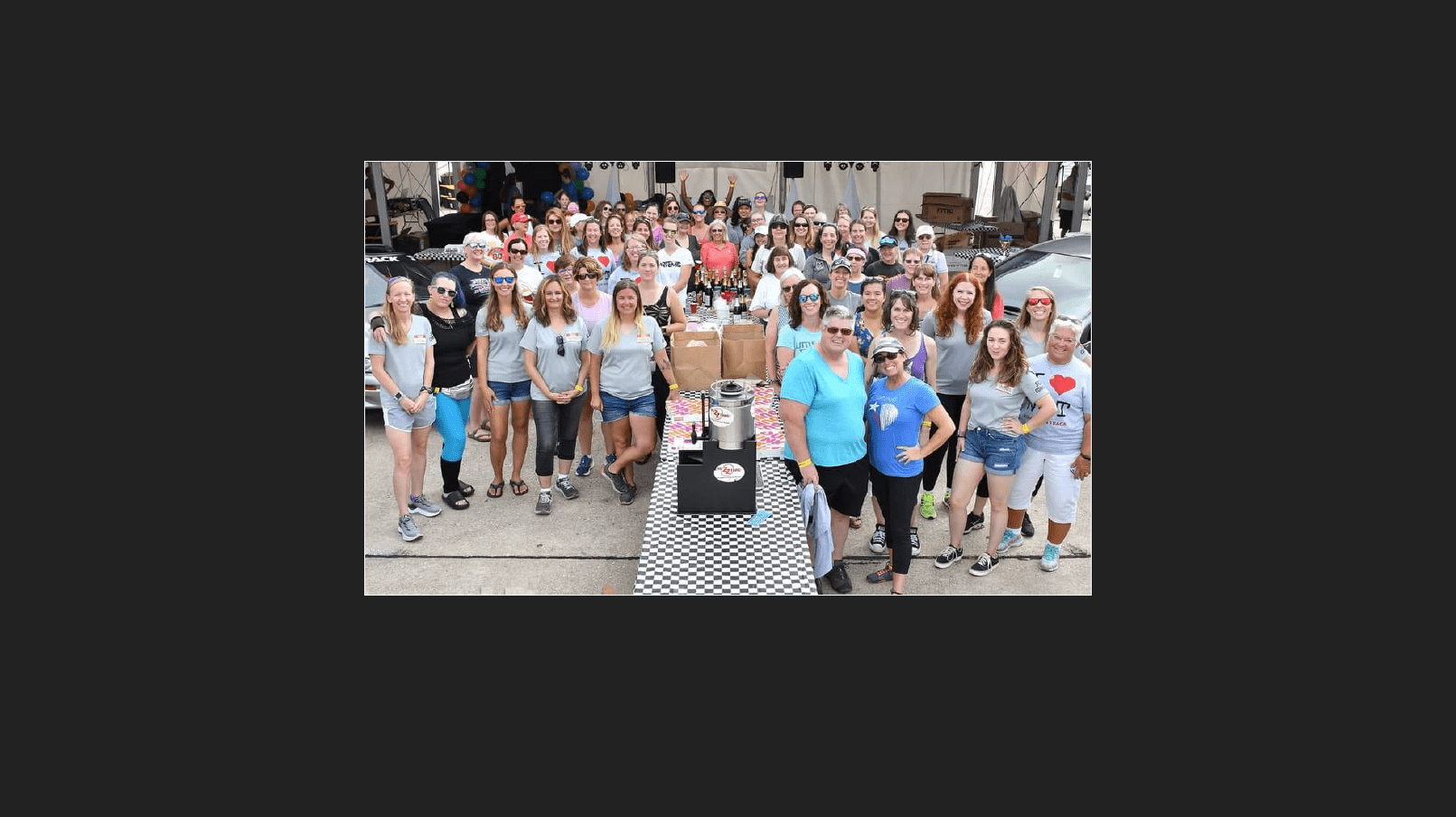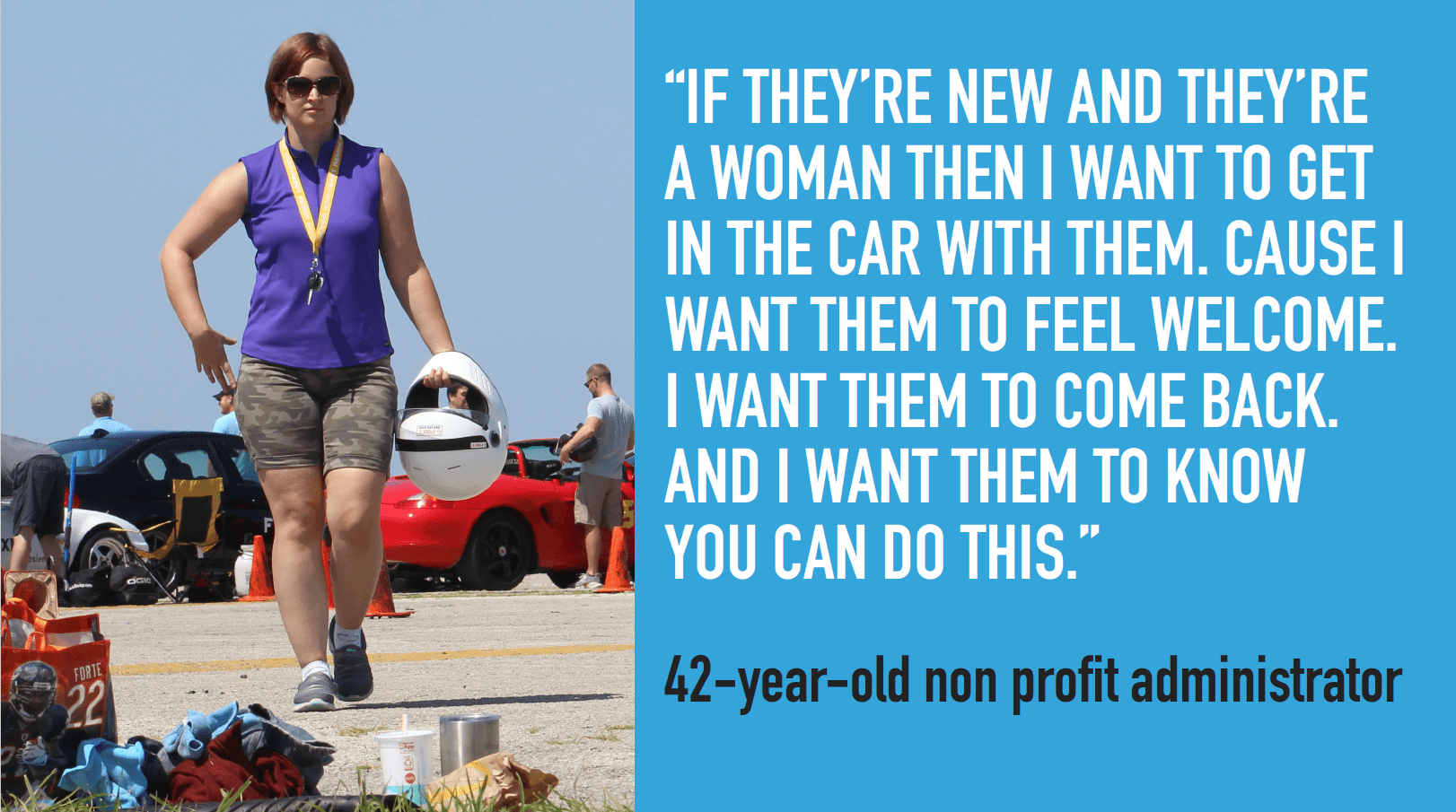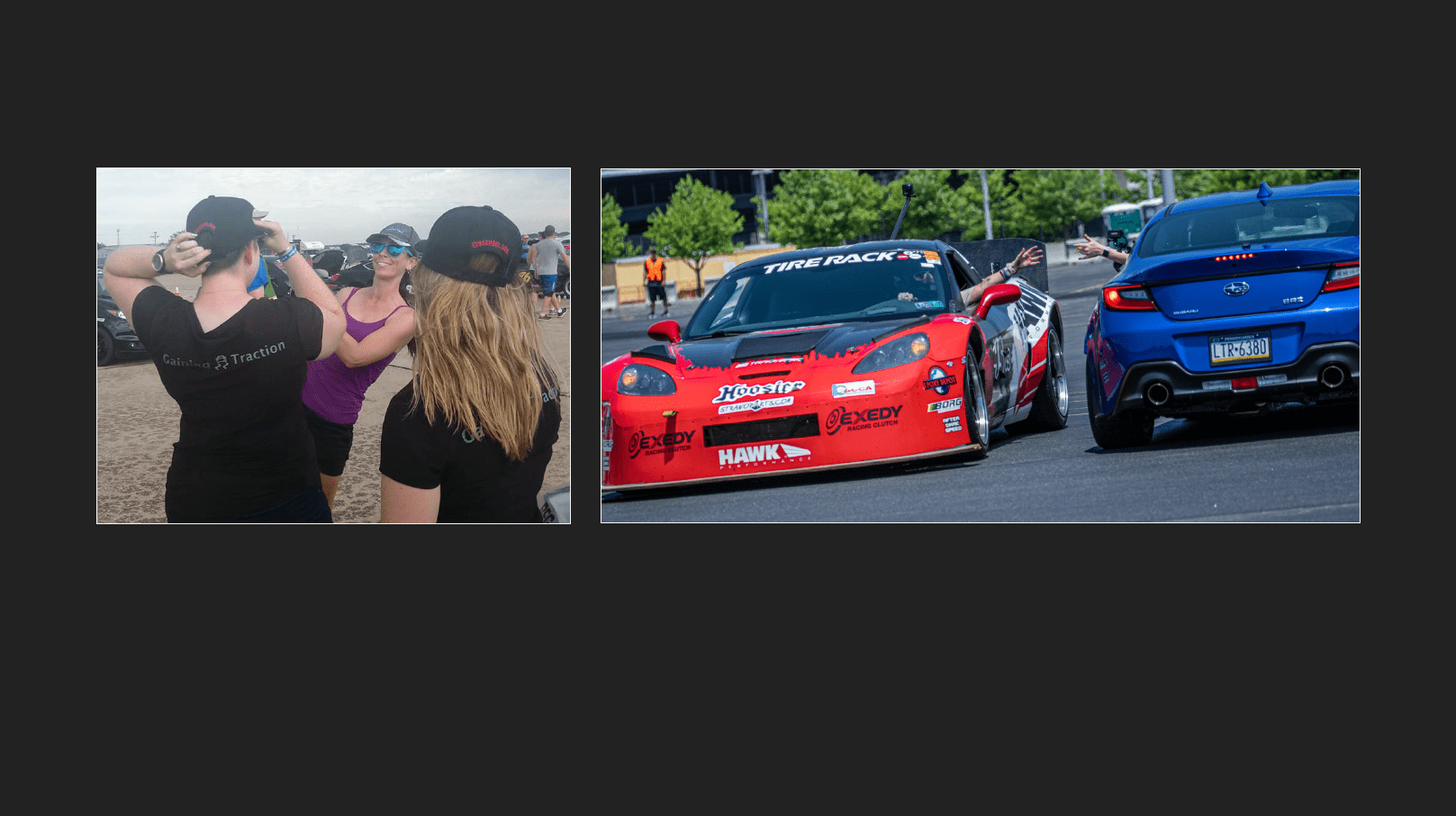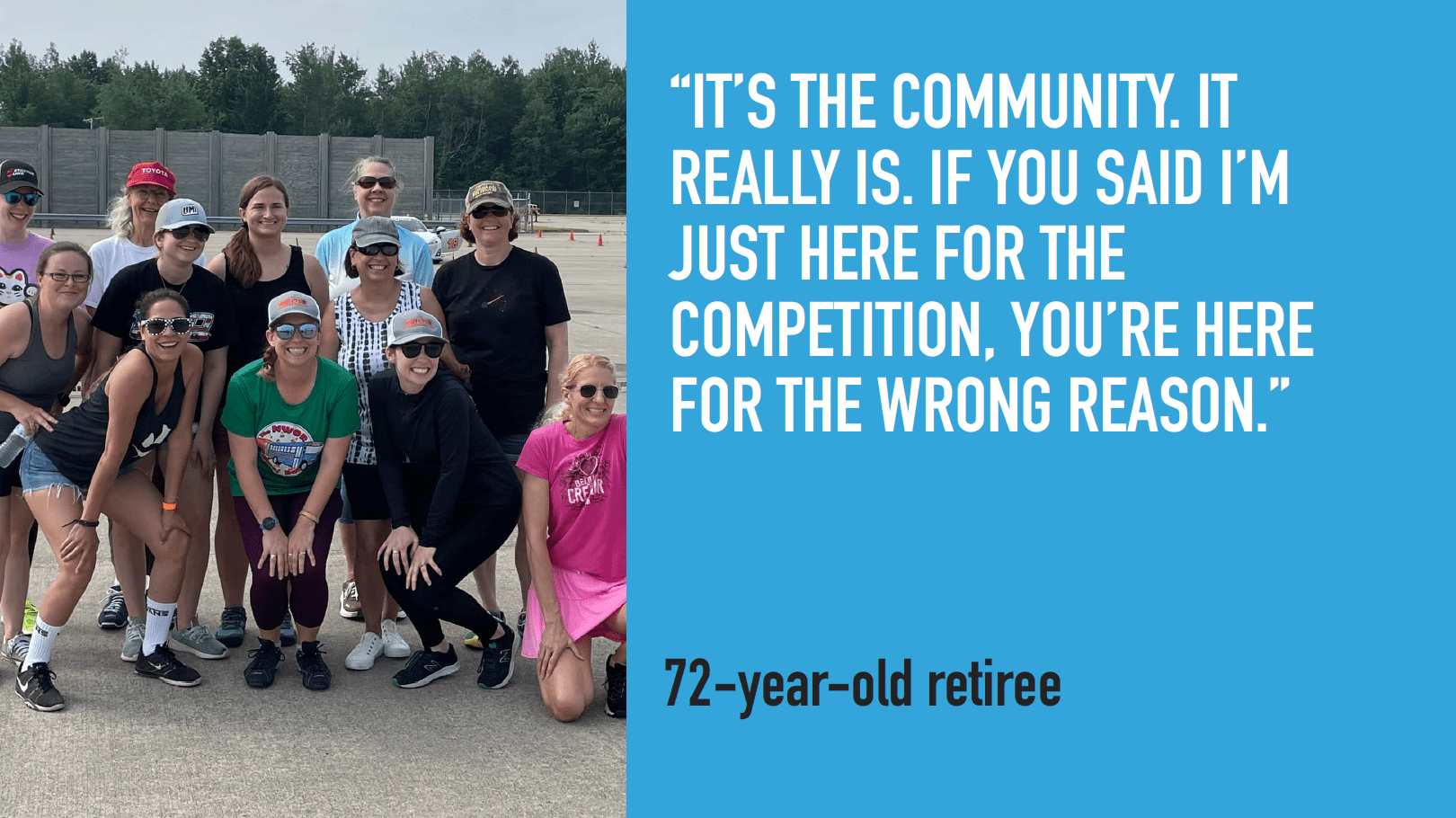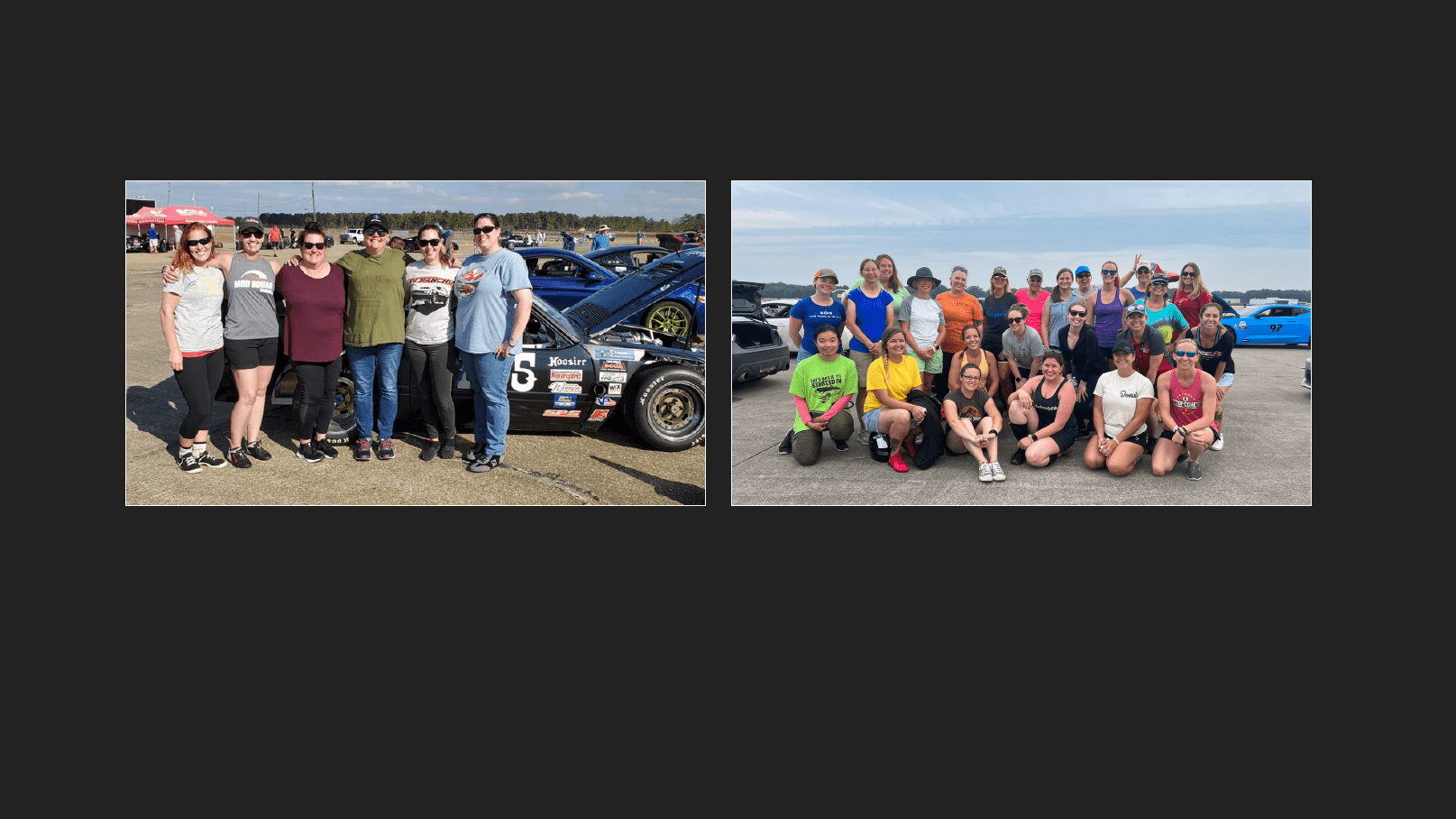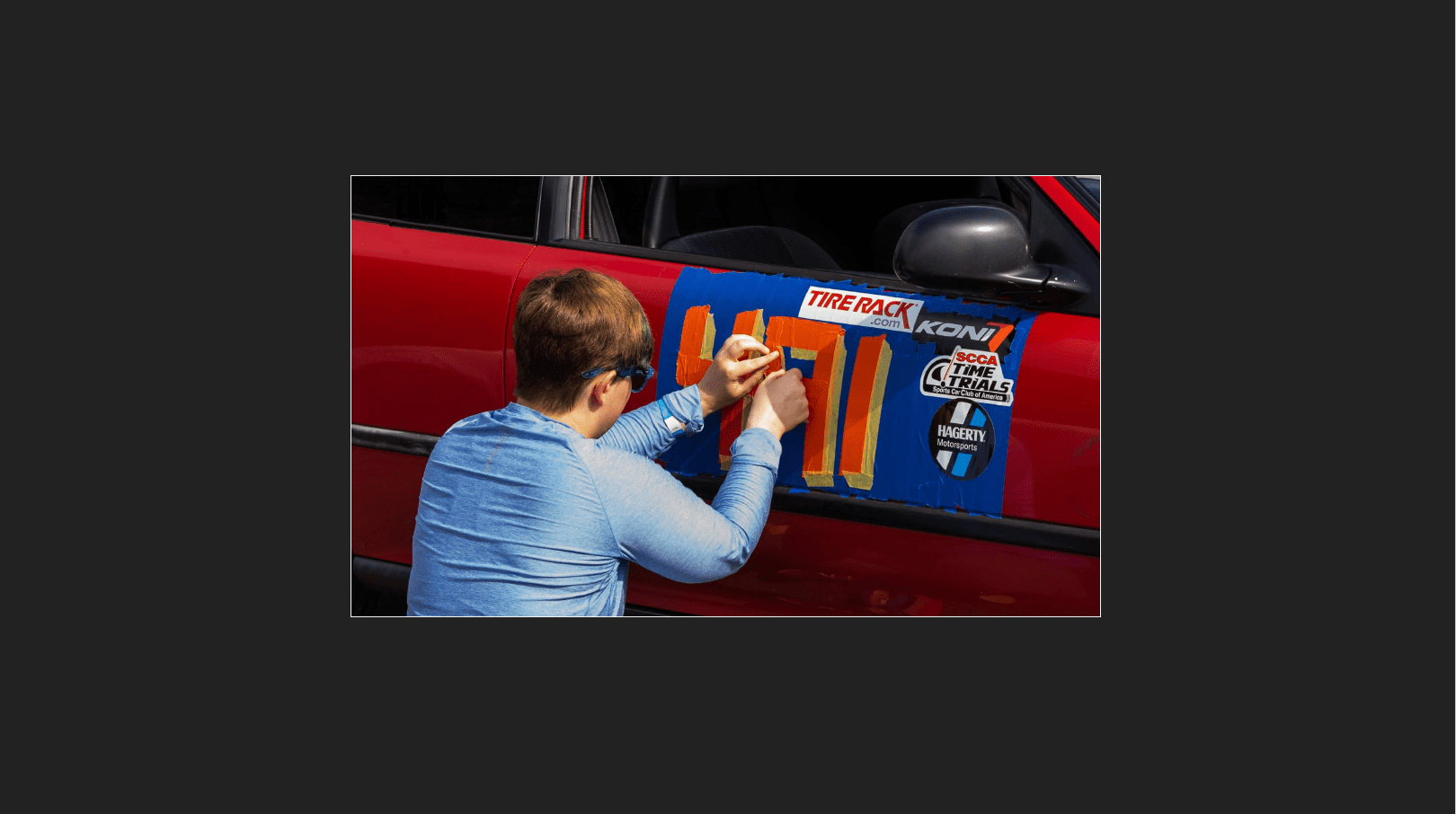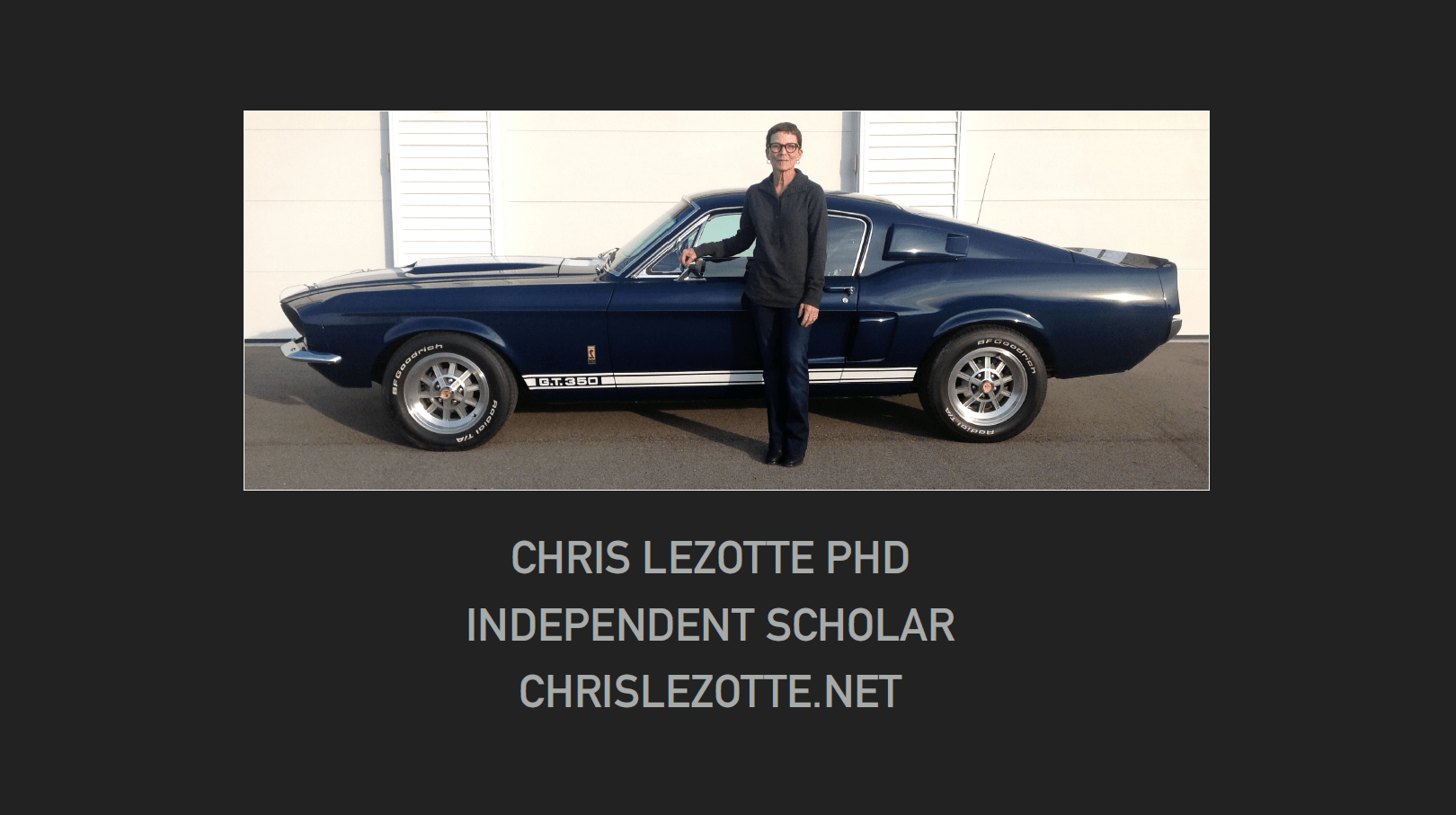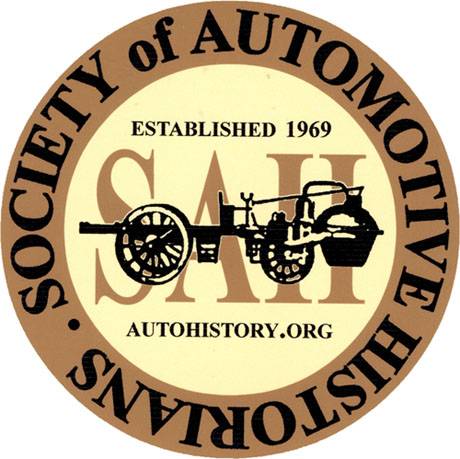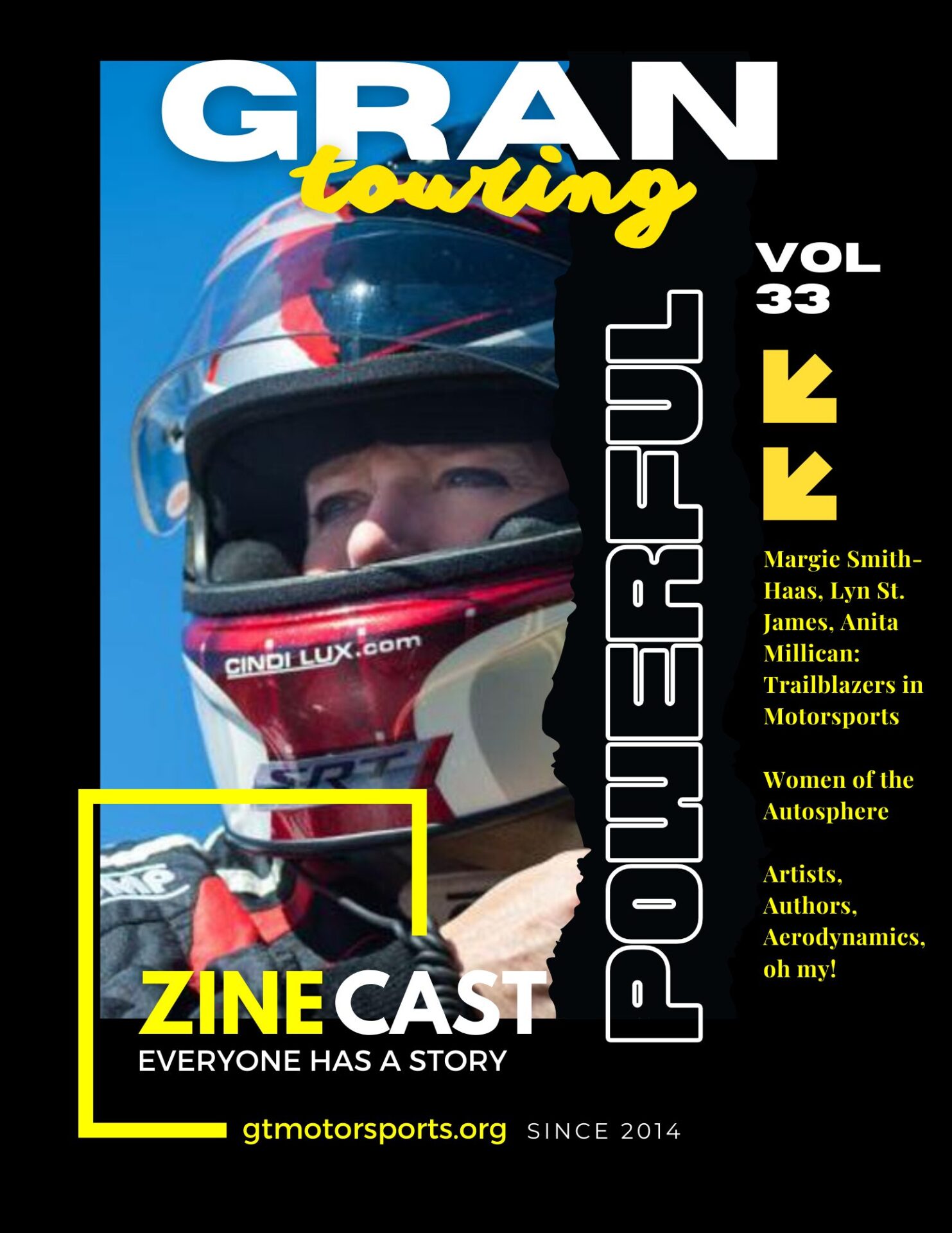Dr. Lezotte’s current project focuses on women’s growing involvement in AutoCross – the reason’s for women’s participation; the methods by which women negotiate entry into a historically masculine environment; and how the AutoCross experience contributes to women’s identity, self-knowledge, and empowerment.
Tune in everywhere you stream, download or listen!
 |  |  |
- Bio
- Notes
- Transcript
- Livestream
- Learn More
Bio
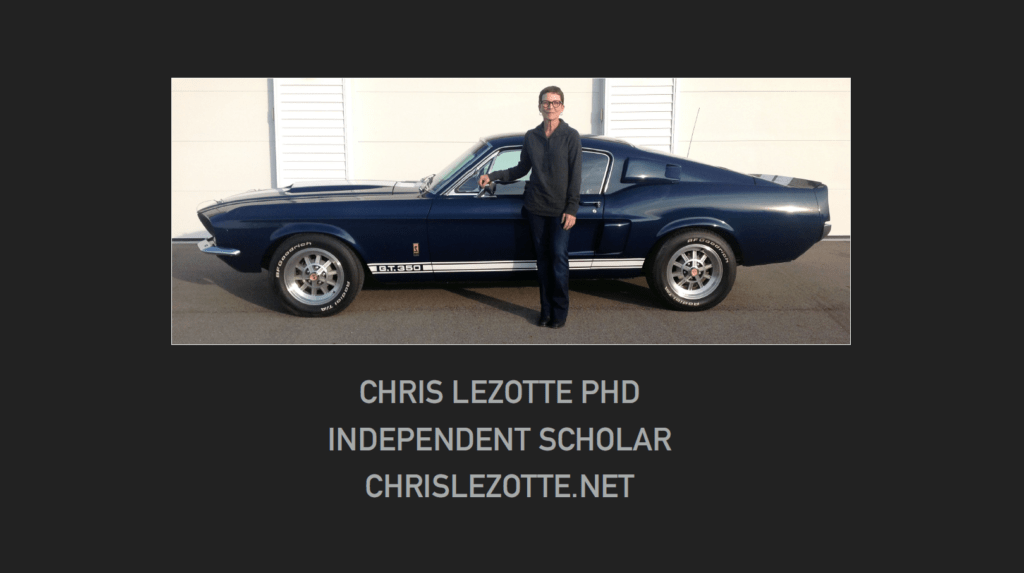
After a career in advertising – some of it spent writing car commercials – Dr. Chris Lezotte earned a master’s degree at Eastern Michigan University and a Ph.D. from Bowling Green State University. Now working as an independent scholar, she investigates the relationship between women and cars in a variety of contexts, including women’s participation in traditionally masculine car cultures (including motorsports) as well as representations of women, and cars in popular culture.
Notes
Transcript
[00:00:00] Hello and welcome to the Gran Touring Motor Sports Podcast Break Fix, where we’re always fixing the break into something motor sports related. The following episode is brought to you in part by the International Motor Racing Research Center, as well as the Society of Automotive Historians, the Watkins Glen Area Chamber of Commerce and the Arts Inger.
Real racers turn in both directions, autocross life skills, and the woman driver by Chris Lizza. After her career in advertising, some of it spent writing commercials. Dr. Lizza earned a master’s degree at Eastern Michigan University and a PhD from Bowling Green State University. Now working as an independent scholar.
She investigates the relationship between women and cars in a variety of contexts, including women’s participation in traditionally masculine. Including motorsports as well as representations of women and cars in popular culture. Dr. Eliza’s current project focuses on women’s growing involvement in autocross, the reasons for women’s participations, and the methods by which [00:01:00] women negotiate entry into a historically masculine environment, and how the autocross experience contributes to women’s identity, self-knowledge, and empower.
Good afternoon everyone, and thank you for your interest in this presentation, which focuses on women’s participation in the motor sport of autocross. I’m Crystal Zan, an independent scholar. The overarching subject of my research is the relationship between women and cars and a variety of contact. Three years ago, in November of 2019, I attended the Argo Singer Conference on the invitation of Don.
At that time, I had recently accepted an invitation to write a chapter focused on the history of women only racing for an upcoming book on the history and politics of motors. I called upon a conference, therefore, not only to become better informed regarding Motor Sports Scholarship, but to also conduct research at the Im rrc.
A big shout out to Jenny Ambrose, who helped me in that endeavor. As part of my investigation for this book project, I interviewed a number of women who posted about their [00:02:00] involvement in motor sports on the SST C a Facebook woman on track. While the women participated in many motor sports arenas, the overwhelming majority I discovered ran an autocross as motorsports are historically unwelcoming to women, I was intrigued by the notion of a motor sports venue that was somewhat effective in attracting female participants.
As one of my primary research interests is women who successfully negotiate entry into masculine car. Such as muscle cars and pickup trucks. I thought that an investigation of women who participate in autocross would be an interesting, perhaps Revelational project to pursue. Of course, shortly after that conference, COVID closed everything down, including a large number of motor sports events, so I had to wait a couple of years before embarking on the autocross study.
I began attending motor sports events in the fall of 2021, and just recently completed the transcription of the last of 31 1 hour interviews conducted with female autocross drivers. I also spent a [00:03:00] great deal of time on social media and locations such as the aforementioned Woman on Track Facebook page, where women ask questions, posted results, and provided support for one another.
This presentation today is a first attempt to introduce my initial. The study of women in autocross is important for a number of reasons. Scholarship on women in motor sports tend to fall into two camps. Sexist attitudes and practices which create barriers to women’s professional motocross participation and monographs focused on the success of exceptional women who have made it in the masculine world of motorsports.
Amateur sports as a potential stepping stone to professional aspirations as a male dominated activity in which men. Or as a source of female identity and empowerment has not been examined. Although women comprise over 50% of licensed drivers. Women’s participation in motorsports at all levels and all types of events is less than 4%.
However, women at have at times represented nearly 20% of autocross [00:04:00] participants on a national level. This suggests that there are qualities of autocross that are particularly appealing to women. And that women have developed successful strategies to become integrated and accepted into the autocross community.
How women negotiate entry in a traditionally hyper-masculine culture, such as motor sports, has relevance not only to activities associated with the automobile, but to any location in which masculinity and male culture hampers women’s participation. Therefore, as I began this investigation into women’s autocross participation, my initial objective was to address the following.
Who are the women who participate in autocross? What strategies do women call upon to gain entry into the autocross arena? What are the qualities that attract women to autocross? How do women benefit from autocross participation? What are the obstacles to women’s autocross participation? And how does women’s participation challenge and reshape autocross?
So what exactly is autocross, although I suspect most of you are [00:05:00] familiar with it, I thought I would provide a short description for those who are not. Autocross is a timed competition in which drivers navigate one at a time through unique course defined by cones or pylons. Autocross events are typically held on flat paved services like parking lots or airport tarmacs with few obstructions.
Unlike racetracks, autocross courses vary in size, surface, and layout. Each event presents a new challenge. Events typically have many classes that allow almost any vehicle with the possible exception of SUVs and pickup trucks to compete. While speeds are generally no greater than those encountered on the highway, success at autocross requires concentration, precision maneuvering, and quick re.
Autocross welcomes drivers of all ages and all abilities. The only equipment required is a driver’s license approved helmet and vehicle. Although I have not participated in an otros as a driver, I observed at two local autocross events held at a driver’s education lot and a regional pro solo event, which took place at the Toledo Airport to gain a [00:06:00] better understanding of otros and the women who run in it, who have the women who participate in otoc.
The women who contributed to this project were recruited from local events as well as the S E C A Woman on Track Facebook page. They arranged an age from 23 to 72 with the largest group, 30% from the 30 to 39 range. The women varied in otros experience levels from less than one year to nearly 50 beginners to national championship winners.
84% were married or partnered, but just 23% had children, 20 identified as non-white and 90% as hetero. Well, women in warm weather states were in the majority, no doubt due to the extended racing seasons in those climates. Women in other areas of the country were well represented in terms of political ideology.
Of those who provided an answer, 60% leaned left. 25% were moderate, and 15% identified as conservative. While the sample size is not large enough to be generalizable, the demographics do provide an interesting [00:07:00] contrast to the white male conservative population that makes up the overwhelming majority of the motor sports population.
This disparity does not only explain why women often have difficulty entering the motor sports arena, but also suggests that in greater numbers, women have the potential to alter the motorsports culture to be more diverse, inclusive, and supportive. So what strategies do women call upon to gain entry into the autocross?
An interest in automobiles in general, and motor sports in particular is not cultivated in the majority of young women. Not only are gendered practices regarding toys that move and forced at a very young age, but women who express more than an average fascination with cars are often labeled unnatural or freakish.
Consequently, women are often unaware of motor sports is something in which they can participate unless encouraged by someone or something with knowledge or interest. While a few of the women came from racing or car-centric. Most were introduced to autocross through car clubs, work environments, other racing communities such as [00:08:00] motorcycles or more often by male, significant others, fathers, brothers, or coworkers.
Many of the men consider the participation of their wiser girlfriends as a way to rationalize their own autocross habit, as well as an opportunity to spend more time together doing something they enjoyed. The women who often shared cars with husbands or boyfriends appreciated the male support and found pleasure and excitement and the shared autocross.
So what are the qualities that attract women to autocross? The first is affordability. Autocross is the most affordable of all motor sports when starting out. Many of the women use daily drivers to see if autocross is something they might want to pursue. Car sharing is encouraged in autocross. Couples often co drive cars, and Carlos women will usually find someone with whom to share a vehicle.
Autocross entries are less expensive than other motorsports, and there is less wear and tear in the car, although avit autocrossers go through a whole lot of tires. Historically and culturally, women have been directed toward practical vehicles. Consequently, it is often difficult for them to [00:09:00] rationalize spending money on something as impractical and excessive As a race car, the use of a daily driver and the ability to car share makes the money directed toward autocross easier to justify.
The women also mention the accessibility of auto. Experience and special driving skills are not required. Autocross is very much a learn as you go motorsport. There are always individuals on hand, eager to ride along with novice drivers, provide instruction and explain the basic. Many of the women began by attending autocross events with boyfriends or husbands as spectators eventually proclaiming that I can do this and taking the wheel themselves.
Another quality that attracts women is safety. Numerous studies have demonstrated that as a population, women are safer drivers than. Culturally, women are considered responsible for family safety and are encouraged to purchase vehicles with an abundance of features that will protect their family and loved ones.
It is no surprise therefore, that most of the women mentioned safety as an important component of autocross. Participation, safety, and [00:10:00] autocross takes two forms. First, autocross organization have established policies and procedures to make sure people on site in cars and on the course. Secondly, the course itself is designed to minimize conditions that could cause harm.
Cars are run one at a time on a flat closed course without obstructions. The only object which could cause car damage is a plastic cone as a test of coordination, concentration, and driving skill rather than power and performance. Cars rarely get above 60 miles an hour. Many of the mothers in the group mentioned that Ocross relieves the worry that something will happen to them on the track.
Although most racing events are associated with high speed risk and. Auto Cross is promoted and experienced as an exciting, exhilarating adrenaline pumping, yet ultimately Safeway to experience Motorsport. The most popular quality that attracts women to otros is camaraderie. Almost all women mentioned that the camaraderie and support of the otros community as a prime motivation for participation as most come to otros with little experience and a lot of [00:11:00] trepidation.
The support of other autocrosses helps to ease tension, build confidence, and become comfortable in the motor sports environment. There is a lot of downtime in auto. With just three to five minutes of actual driving each day. The women use time spent in the grid and the impound to talk with other drivers, discuss what went right and what went wrong, and learn from each other.
They talk about cars at lunch, at setups, or while working on the site. Ocos is a volunteer activity. If you run, you have to work. So helping with registration, working the course, spending an hour in the timing trailer or volunteering as an instructor provides time to socialize while gaining a better understanding of the sport.
Many of the women are active on social media and develop online friendships. Some attend regional and national events with a large group of female entrants, provide a sense of solidarity and empowerment. Many of the women refer to the otros community as family and feel that otros has extended their circle of.
To all corners of the country. One of the ways camaraderie has nurtured is the ladies classes. However, as an activity in which men and [00:12:00] women are segregated, there is always controversy. Those opposed to ladies classes believe that women can only improve by beating the boys. Those in favor cite the potential increase in female participation generated by ladies classes.
Many women start in ladies and move to open once their confidence and skill levels have. some run and open locally where there’s often little competition in ladies and switched to ladies at regional and national events. I attended a regional event at which there were large ladies classes in the camaraderie and support among the participants was palpable.
The women began the day by joining in a group dance, and the grid then congratulated and commiserated with each other in the impound after all had completed their. Photos from the STCA solo nationals held in Lincoln, Nebraska featured a dozen of photos with women from all over the country joining together in solidarity.
As many of the women mentioned when gathered together in the ladies classes, they feel confident and newly empowered. So how do women benefit from autocross participation? Many of the women mentioned how [00:13:00] autocross changed the relationship with the automobile in significant. Not only does Otros provide the opportunity to understand the car better, but it teaches important driving skills that translate to everyday life.
Otros also provides an experience unequal than daily driving, the thrill of driving fast, the adrenaline of competition, the opportunity to continue improve one’s performance, the mental challenge, the chance to be a badass behind the wheel. Many of the women enjoy the surprise of others when they discovered that the mild mannered school teacher or uptight business manager auto crosses on the weekends.
Otros can change women. They become more confident in their skills and in themselves more outgoing and self-assured in relationship with others. Better equipped to handle stress in everyday life and closer to those with whom they share at the otros experience. Those who do especially well in otros have unique opportunities to compete for national championships, test drive cars in other parts of the country, and become ambassadors for all Autocrossing women.
What are the obstacles to women’s particip? In order to [00:14:00] consider participating in otros, one has to know what exists. Most women are unaware that engaging in motor sports on such an accessible and affordable level is possible. Those who do find their way to an otros event often start out fearful, not by the course or getting behind the wheel, but are nervous.
They will embarrass themselves in front of friends, family, and most especially the men in attendance. Positive interactions with newcomers to autocross are essential for retaining new. Those who have remained in otros cite the camaraderie of the otros community as responsible for their continued participation.
The woman I spoke to mentioned how in the beginning they were able to get over their fears through the actions and assistance of more experienced drivers, especially other women. Now that they have gained confidence as drivers, the women actively play it forward to otros novices. Out of the 31 women interviewed for this project, only seven had.
This points to the biggest obstacle in female participation, how to accommodate families so that women can drive. As culturally, women are considered responsible for [00:15:00] childcare. If someone has to stay home with the kids while the other ones at otros, it is almost always the female partner. Women within autocross organizations have developed groups to specifically address the obstacles that hamper women in the sport.
One of the key tasks was to create an environment that encourages family particip. The ladies’ classes were in fact, developed and part addressed this issue. If a couple shares a car, but not the same class, one parent can watch the kids while the other competes. This has allowed women who had reluctantly stayed at home to not only have the opportunity to run, but to share in a mutually enjoyable activity with the family.
Historically, motorsports has been dominated by white conservative men as indicated by many of the women. Some of the old timers have misogynistic views that hamper, if not discouraged females, particip. Women who participate with male partners are often somewhat shielded from this type of behavior.
Those who don’t either learn to avoid such individuals or learn to let it roll off their backs. Women within the autocross community work diligently to make the environment a welcoming [00:16:00] one. While this has been mostly successful in the ladies’ classes, there need to be more women in autocross on all levels, particularly in leadership positions to affect that kind of cultural change.
How does women’s participation challenge and reshape autocross culture? Women in autocross understand that it is on them to increase female participation. Often this means gaining respect and working their way into places of authority within various motorsports. Organizations becoming active in autocross clubs and programs provides the opportunity to create and implement policies beneficial to the female.
Many of the women I spoke to, volunteers as committee chairs, club officers, program directors, newsletter editors, photographers, graphic designers, social media administrators in a multitude of other positions that provide access and influence to the otros community. Others take part on a more basic level By volunteering as instructors and creating a welcoming environment for those new to the sport.
Women-led groups within otros organizations work to serve the needs of female. They not only develop [00:17:00] strategies to recruit more women to otros, but also work to secure sponsors to create scholarship opportunities for novice women. By working from within, women at Otros have the opportunity not only to increase female participation, but in doing so, change the culture of autocross from a historically white masculine fraternity to a diverse and inclusive community that welcomes all.
Autocross is an amateur activity. Although women have achieved great success on the otros stage, the sport is rarely a route to a professional career in motor sports. Rather, it is an activity taken on for its challenges, thrills, uniqueness, fun, and most importantly, comradery. It provides an opportunity to develop friendships with those who share an interest from all walks of life, from all over the country.
For those with auto crossing partners, it is a chance to spend time together in a mutually enjoyed PAs. To the women in Aros, success is not only measured by time on the clock. Rather, it’s about successfully applying oneself to an undertaking that is challenging, invigorating, exhausting, and ultimately rewarding.
It’s about [00:18:00] learning and improving skills one run at a time. It is about bringing other women into the sport and helping teaching commiserating and encouraging them. It is about creating a supportive, welcoming, and empowering community, not just for women, but for everyone involved in the autocross hobby.
That concludes this presentation. Thank you for your attention and I am welcome to any questions
underneath. Can you tell me how to get in touch with is S C C and get my wife involved in this? Yes, I can. I’ll, I interviewed her. Yeah. Do any of the women involved in autocross move up to another category like a track racing or rattling? Some. Some do. I was curious about that. Some of them do track days and they do driver’s education, but very few of them go on to any wheel to wheel competition.
Problem with those activities is they’re more expensive, gasoline’s expensive. It’s more wear and tear in the car, so most of them just [00:19:00] stick to ox and a lot of them have been doing it for 40 or 50 years. I’ve been doing it for a really long time. Some of them are quite. Okay. They have national championships.
So another way to come at this is to look at an organization that promotes this kind of thing. I, I was thinking about the Porsche Club of America, as you spoke, whose slogan, by the way, is it’s not the cars, it’s the people. They’re propaganda. All media is filled with, um, the sense that this is a family friendly set of activities.
Many photographs of men and women, although generally heterosexual couples at the same time. It’s pretty. The power brokers within the organization at various levels are nearly all male. And the little bit of marketing information I’ve seen, particularly if you exclude the, the SUVs show that nearly all Porsche purchasers or leasers are males.
It’s a kind of a difficult situation. Right. Well, I actually, one of the women I spoke to started an outros through the Porsche Club. She and her husband drive boxers, but she [00:20:00] mentioned that they don’t have ladies. In the Porsche Club, all everybody has to run an open. So if you’re sharing a car that becomes problematic.
It’s okay if you don’t have children, but if you do, then it’s an issue. But like I said, most of the women I talked to didn’t have children, and perhaps that’s what made them able to participate this for a long period of time. If I missed it, I apologize. But have you done this yourself or in all of the research that you were doing, did you get the urge to get behind the wheel and do it yourself?
Uh, no, I have not. And I am too old to start, but I would like to ride along with somebody that I think that would be all right. But I don’t wanna really wanna try it myself. I’m not that confident. Number a driver. I didn’t know it existed when I was younger. I think it should be pointed out that the national S C C A National Solo Championship is probably one of the largest motor sport events in the world.
Yes. In Lincoln, Nebraska. As a former director of S C C A, I’ve watched this sport develop and come up and it used to be yes, it, a lot of people did, did our crossing went [00:21:00] into racing. It doesn’t seem to be that crossover anymore. Most of the people who go autocrossing do Autocrossing, and that’s, that’s as far as they.
but it is still an incredibly popular event and it is, as I say, once again, I’ve forgotten the exact numbers, but I think it approaches a thousand then. Yeah, I think they had 1200 this year and they had a lot of women teach sounds. Right. I know some friends who were went. Yeah. A lot of the women I talked to were went and that’s the event you should go to.
Yeah, it’s in October. Hi, my name is Lee Martinez and I’m very active in the Porsche Club of America. I used to be the president of the Finger Lakes region and I’m a track instructor here at Watkins Glen and I have been for over 20 years. Just going to give you a few positive examples of women in Porsche Club of America.
The youngest ever track instructor certified by P C A by Porsche Club of America. America is Ashley Novak. She was 18 years old and she was a track instructor here and elsewhere. And uh, now of course she’s married and has a family. Another positive example [00:22:00] is Aurora Straus. Her father’s a Strauss, Aurora Strauss.
I remember when she was 11 years old, 12 years old, and she was being taught how to drive at Monticello Motor Club in uh Monticello, New York today. She’s a professional AMSA driver as well as a Harvard graduate. Just last week I released a story that went to the PCA Club Racing News, which is based in California about a husband, wife.
Club racing teams, Steve and Mary Shindler, whom I’ve known, and they were here in June and I wrote a story about Mary and Steve, and they each have what I call his and Herst car. And they both, they change in, I mean, they race in different categories, but they do race. I could go on with many examples of being active in, uh, Club racing sports, uh, for over 50 years.
Thank you. Mm-hmm. , with your background in writing car commercials, I was thinking you might be the perfect person to do, um, a presentation or a book on a woman in, um, automotive advertising. Any thoughts on that? I’d like to leave [00:23:00] my advertising pass behind. But I did write an article that was in the um, automotive history review about my time spent at McCann Erickson working on Buick and GMC Truck, and I did do some advertising that focused on women, which at the time, this was in the eighties, which was very unusual at the time.
But as a book, nah. No, but thanks for the idea. In which states do most of this auto cross? Happen. Well, the women I talked to were, a lot of them were on the West Coast, but there were also people in Utah, Texas, Georgia, Florida, New York. They were pretty much from all over. I think they just have a longer racing season on the west coast than they do obviously in the north.
Well, I know they ought across in the rain. I don’t know if they ought to cross on the ice, but thank you, Chris.
This episode is brought to you in part by the International Motor [00:24:00] Racing Research Center. Its charter is to collect, share, and preserve the history of motorsports spanning continents, eras, and race series. The Center’s collection embodies the speed, drama, and comradery of amateur and professional motor racing throughout the world.
The Center welcome series researchers and casual fans alike to share stories of race, drivers race series, and race cars captured on their shelves and walls, and brought to life through a regular calendar of public lectures and special events. To learn more about the center, visit www.racing archives.org.
This episode is also brought to you by the Society of Automotive Historians. They encourage research into any aspect of automotive history. The s a h actively supports the compilation and preservation of papers. Organizational records, print ephemera and images to safeguard, as well as to broaden and deepen the understanding of motorized wheeled land transportation through the modern age and into the future.
For more information about the s A h, visit www.auto history.org.[00:25:00]
If you like what you’ve heard and want to learn more about gtm, be sure to check us out on www.gt motorsports.org. You can also find us on Instagram at Grand Tour Motorsports. Also, if you want to get involved or have suggestions for future shows, you can call our text at (202) 630-1770 or send us an email at crew chief gt motorsports.org.
We’d love to hear from, Hey everybody, crew Chief Eric here. We really hope you enjoyed this episode of Break Fix, and we wanted to remind you that GTM remains a no annual fees organization, and our goal is to continue to bring you quality episodes like this one at no charge. As a loyal listener, please consider subscribing to our Patreon for bonus and behind the scenes content, extra goodies and GTM swag.
For as little as $2 and 50 cents a month, you can keep our developers, writers, editors, casters, and other [00:26:00] volunteers fed on their strict diet of Fig Newton’s, gummy bears, and monster. Consider signing up for Patreon today at www.patreon.com/gt motorsports. And remember, without fans, supporters, and members like you, none of this would be possible.
Livestream
Learn More
 If you enjoyed this History of Motorsports Series episode, please go to Apple Podcasts and leave us a review. That would help us beat the algorithms and help spread the enthusiasm to others. Subscribe to Break/Fix using your favorite Podcast App:
If you enjoyed this History of Motorsports Series episode, please go to Apple Podcasts and leave us a review. That would help us beat the algorithms and help spread the enthusiasm to others. Subscribe to Break/Fix using your favorite Podcast App: |  |  |
Consider becoming a Patreon VIP and get behind the scenes content and schwag from the Motoring Podcast Network
Do you like what you've seen, heard and read? - Don't forget, GTM is fueled by volunteers and remains a no-annual-fee organization, but we still need help to pay to keep the lights on... For as little as $2.50/month you can help us keep the momentum going so we can continue to record, write, edit and broadcast your favorite content. Support GTM today! or make a One Time Donation.
This episode is sponsored in part by: The International Motor Racing Research Center (IMRRC), The Society of Automotive Historians (SAH), The Watkins Glen Area Chamber of Commerce, and the Argetsinger Family – and was recorded in front of a live studio audience.
Other episodes you might enjoy
Michael R. Argetsinger Symposium on International Motor Racing History
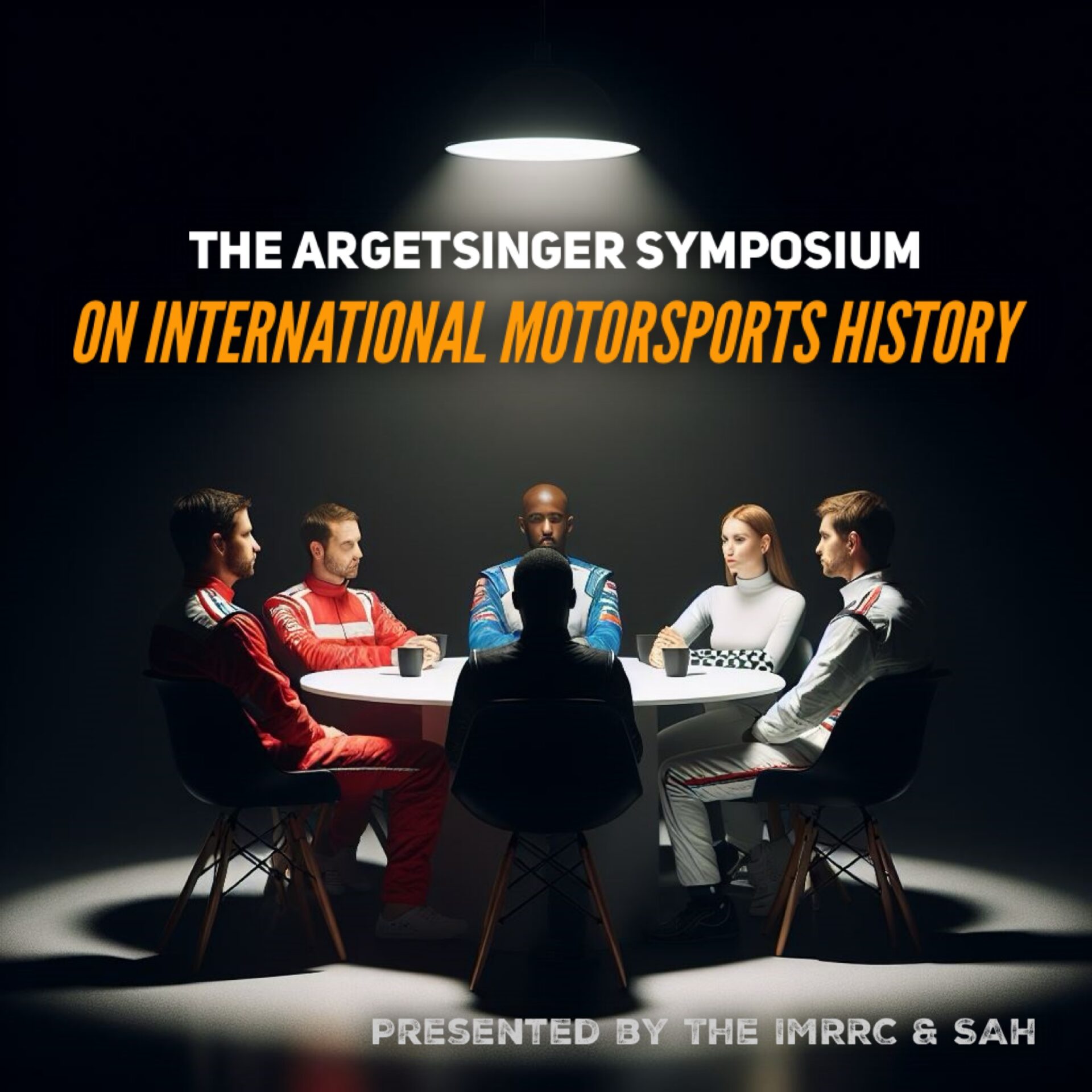 The International Motor Racing Research Center (IMRRC), partnering with the Society of Automotive Historians (SAH), presents the annual Michael R. Argetsinger Symposium on International Motor Racing History. The Symposium established itself as a unique and respected scholarly forum and has gained a growing audience of students and enthusiasts. It provides an opportunity for scholars, researchers and writers to present their work related to the history of automotive competition and the cultural impact of motor racing. Papers are presented by faculty members, graduate students and independent researchers.The history of international automotive competition falls within several realms, all of which are welcomed as topics for presentations, including, but not limited to: sports history, cultural studies, public history, political history, the history of technology, sports geography and gender studies, as well as archival studies.
The International Motor Racing Research Center (IMRRC), partnering with the Society of Automotive Historians (SAH), presents the annual Michael R. Argetsinger Symposium on International Motor Racing History. The Symposium established itself as a unique and respected scholarly forum and has gained a growing audience of students and enthusiasts. It provides an opportunity for scholars, researchers and writers to present their work related to the history of automotive competition and the cultural impact of motor racing. Papers are presented by faculty members, graduate students and independent researchers.The history of international automotive competition falls within several realms, all of which are welcomed as topics for presentations, including, but not limited to: sports history, cultural studies, public history, political history, the history of technology, sports geography and gender studies, as well as archival studies.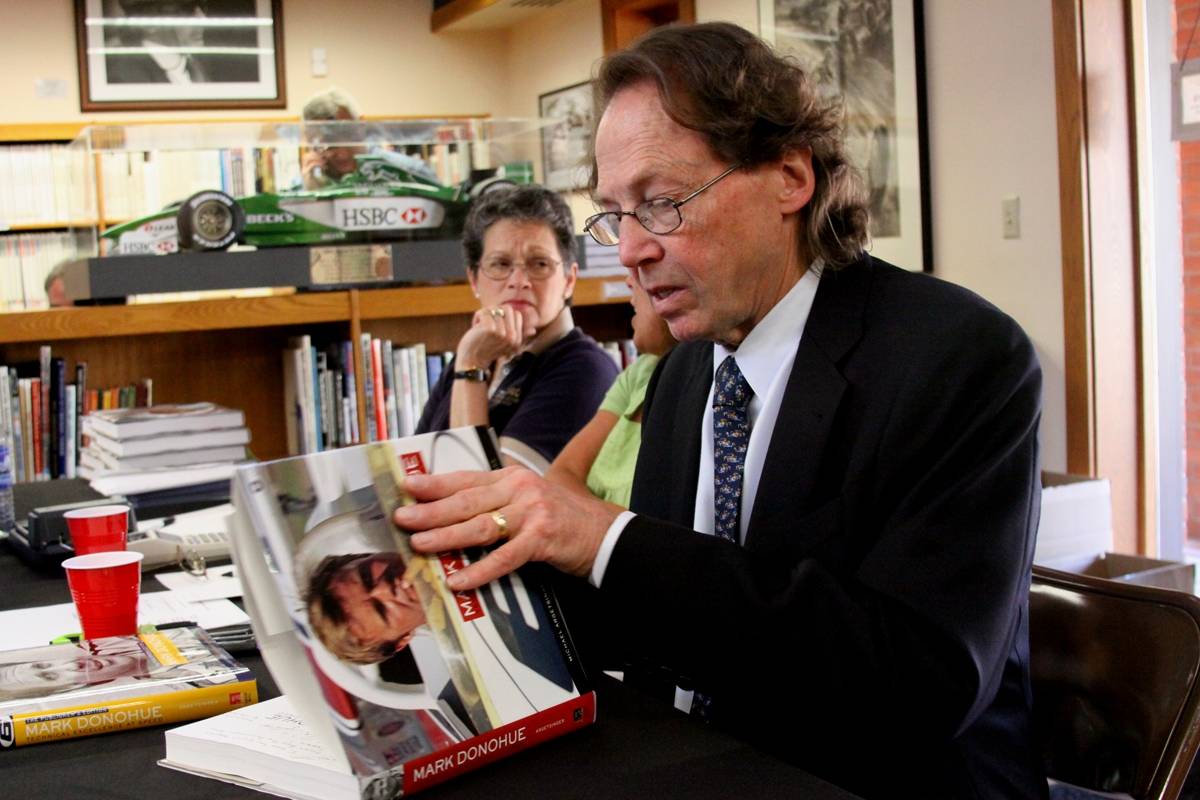 The symposium is named in honor of Michael R. Argetsinger (1944-2015), an award-winning motorsports author and longtime member of the Center's Governing Council. Michael's work on motorsports includes:
The symposium is named in honor of Michael R. Argetsinger (1944-2015), an award-winning motorsports author and longtime member of the Center's Governing Council. Michael's work on motorsports includes:- Walt Hansgen: His Life and the History of Post-war American Road Racing (2006)
- Mark Donohue: Technical Excellence at Speed (2009)
- Formula One at Watkins Glen: 20 Years of the United States Grand Prix, 1961-1980 (2011)
- An American Racer: Bobby Marshman and the Indianapolis 500 (2019)



